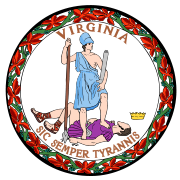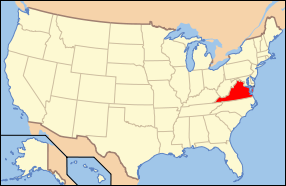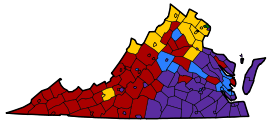Virginia
| Commonwealth of Virginia | |||||||||||
|
|||||||||||
| Official language(s) | English | ||||||||||
| Spoken language(s) | English 94.6%, Spanish 5.9% | ||||||||||
| Demonym | Virginian | ||||||||||
| Capital | Richmond | ||||||||||
| Largest city | Virginia Beach | ||||||||||
| Largest metro area | Northern Virginia | ||||||||||
| Area | Ranked 35th in the US | ||||||||||
| - Total | 42,774.2 sq mi (110,785.67 km2) |
||||||||||
| - Width | 200 miles (320 km) | ||||||||||
| - Length | 430 miles (690 km) | ||||||||||
| - % water | 7.4 | ||||||||||
| - Latitude | 36° 32′ N to 39° 28′ N | ||||||||||
| - Longitude | 75° 15′ W to 83° 41′ W | ||||||||||
| Population | Ranked 12th in the US | ||||||||||
| - Total | 7,882,590 (2009 est.)[2] | ||||||||||
| - Density | 193/sq mi (75/km2) Ranked 14th in the US |
||||||||||
| - Median income | $61,044[3] (8th) | ||||||||||
| Elevation | |||||||||||
| - Highest point | Mount Rogers[4] 5,729 ft (1,747 m) |
||||||||||
| - Mean | 950 ft (290 m) | ||||||||||
| - Lowest point | Atlantic Ocean[4] 0 ft (0 m) |
||||||||||
| Before statehood | Colony of Virginia | ||||||||||
| Admission to Union | June 25, 1788 (10th) | ||||||||||
| Governor | Bob McDonnell (R) | ||||||||||
| Lieutenant Governor | Bill Bolling (R) | ||||||||||
| Legislature | General Assembly | ||||||||||
| - Upper house | Senate | ||||||||||
| - Lower house | House of Delegates | ||||||||||
| U.S. Senators | Jim Webb (D) Mark Warner (D) |
||||||||||
| U.S. House delegation | 6 Democrats, 5 Republicans (list) |
||||||||||
| Time zone | Eastern: UTC−5/−4 | ||||||||||
| Abbreviations | VA US-VA | ||||||||||
| Website | http://www.virginia.gov | ||||||||||
The Commonwealth of Virginia ( /en-us-Virginia.oggvərˈdʒɪnjə/) is a U.S. state on the Atlantic Coast of the Southern United States. Virginia is nicknamed the "Old Dominion" and sometimes the "Mother of Presidents" because it is the birthplace of eight U.S. presidents. The geography and climate of the state are shaped by the Blue Ridge Mountains and the Chesapeake Bay, which provide habitat for much of its flora and fauna. The capital of the Commonwealth is Richmond; Virginia Beach is the most populous city and Fairfax County the most populous political subdivision. The state population is nearly eight million.[5]
The area's history begins with several indigenous groups, including the Powhatan. In 1607 the London Company established the Colony of Virginia as the first permanent New World English colony. Land from displaced Native American tribes and slave labor each played a significant role in the colony's early politics and plantation economy. Virginia was one of the Thirteen Colonies in the American Revolution and joined the Confederacy in the American Civil War, during which Richmond was the Confederate capital and the state of West Virginia separated. Although traditionally conservative and historically part of the South, both major national parties are competitive in modern Virginia.[6]
The Virginia General Assembly is the oldest legislature in the Americas. The state government has been repeatedly ranked most effective by the Pew Center on the States.[7] It is unique in how it treats cities and counties equally, manages local roads, and prohibits its governors from serving consecutive terms. Virginia's economy has many sectors: agriculture in places like the Shenandoah Valley; federal agencies in Northern Virginia, including the headquarters of the Department of Defense and CIA; and military facilities in Hampton Roads, the site of the region's main seaport. The growth of the media and technology sectors has made computer chips the state's leading export, with the industry based on the strength of Virginia's public schools and universities.[8]
Contents |
Geography
Virginia has a total area of 42,774.2 square miles (110,784.67 km2), including 3,180.13 square miles (8,236.5 km2) of water, making it the 35th-largest state by area.[9] Virginia is bordered by Maryland and Washington, D.C. to the north and east; by the Atlantic Ocean to the east; by North Carolina and Tennessee to the south; by Kentucky to the west; and by West Virginia to the north and west. Due to a peculiarity of Virginia's original charter, its boundary with Maryland and Washington, D.C. does not extend past the low-water mark of the south shore of the Potomac River (unlike many boundaries that split a river down the middle).[10] The southern border is defined as the 36° 30′ parallel north, though surveyor error led to deviations of as much as three arcminutes.[11]
Geology and terrain

The Chesapeake Bay separates the contiguous portion of the Commonwealth from the two-county peninsula of Virginia's Eastern Shore. The bay was formed following a meteoroid impact crater during the Eocene.[12] Many of Virginia's rivers flow into the Chesapeake Bay, including the Potomac, Rappahannock, James, and York, which create three peninsulas in the bay.[13][14] Geographically and geologically, Virginia is divided into five regions from east to west: Tidewater, Piedmont, Blue Ridge Mountains, Ridge and Valley, and Cumberland Plateau, also called the Appalachian Plateau.[15]
The Tidewater is a coastal plain between the Atlantic coast and the fall line. It includes the Eastern Shore and major estuaries which enter the Chesapeake Bay. The Piedmont is a series of sedimentary and igneous rock-based foothills east of the mountains which were formed in the Mesozoic.[16] The region, known for its heavy clay soil, includes the Southwest Mountains.[17] The Blue Ridge Mountains are a physiographic province of the chain of Appalachian Mountains with the highest points in the state, the tallest being Mount Rogers at 5,729 feet (1,746 m).[18] The Ridge and Valley region is west of the mountains, and includes the Great Appalachian Valley. The region is carbonate rock based, and includes Massanutten Mountain.[19] The Cumberland Plateau and the Cumberland Mountains are in the south-west corner of Virginia, below the Allegheny Plateau. In this region rivers flow northwest, with a dendritic drainage system, into the Ohio River basin.[20]
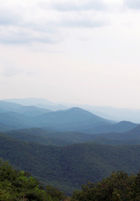
Because of the areas of carbonate rock, more than 4,000 caves exist in Virginia, with ten open for tourism.[22] The Virginia seismic zone has not had a history of regular activity. Earthquakes are rarely above 4.5 on the Richter magnitude scale because Virginia is located centrally on the North American Plate. The largest earthquake, at an estimated 5.9 magnitude, was in 1897 near Blacksburg.[23] Coal mining takes place in the three mountainous regions at 40 distinct coal beds near Mesozoic basins.[24] Besides coal, resources such as slate, kyanite, sand, and gravel are mined, with an annual value over $2 billion as of 2006[update].[25]
Climate
| Climate chart () | ||||||||||||||||||||||||||||||||||||||||||||||||||||||||||||
|---|---|---|---|---|---|---|---|---|---|---|---|---|---|---|---|---|---|---|---|---|---|---|---|---|---|---|---|---|---|---|---|---|---|---|---|---|---|---|---|---|---|---|---|---|---|---|---|---|---|---|---|---|---|---|---|---|---|---|---|---|
|
||||||||||||||||||||||||||||||||||||||||||||||||||||||||||||
|
||||||||||||||||||||||||||||||||||||||||||||||||||||||||||||
The climate of Virginia varies according to location, and becomes increasingly warmer and humid farther south and east.[26] Virginia experiences seasonal extremes, from average lows of 26 °F (−3 °C) in January to average highs of 86 °F (30 °C) in July. The moderating influence of the ocean from the east, powered by the Gulf Stream has a strong effect on the southeastern coastal areas of the state. It also creates the potential for hurricanes near the mouth of Chesapeake Bay.[27] Although Hurricane Camille devastated Nelson County in 1969, and Fran and Isabel caused flash flooding in the mountains in 1996 and 2003, hurricanes rarely threaten communities far inland.[26][28]
Thunderstorms are a regular occurrence, particularly in the western part of the state. Virginia has an annual average of 35−45 days of thunderstorm activity, and an average annual precipitation of 42.7 inches (1,085 mm).[27][29] Cold air masses arriving over the mountains in winter, can lead to significant snowfalls, such as the Blizzard of 1996 and winter storms of 2009–2010. The interaction of these elements with the state's topography creates distinct microclimates in the Shenandoah Valley, the mountainous southwest, and the coastal plains.[30] Virginia averages seven tornadoes annually, though most are F2 or lower on the Fujita scale.[31]
In recent years, the expansion of the southern suburbs of Washington, D.C. into Northern Virginia has introduced an urban heat island primarily caused by increased absorption of solar radiation in more densely populated areas.[32] In the American Lung Association's 2009 report, 15 counties received failing grades for air quality, with Fairfax County having the worst in the state, due to automobile pollution.[33][34] Haze in the mountains is caused in part by coal power plants.[35]
Flora and fauna
Forests cover 65% of the state, primarily with deciduous, broad leaf trees.[36] Lower altitudes are more likely to have small but dense stands of moisture-loving hemlocks and mosses in abundance, with hickory and oak in the Blue Ridge.[26] However since the early 1990s, Gypsy moth infestations have eroded the dominance of oak forests.[37] Other common trees and plants include chestnut, maple, tulip poplar, mountain laurel, milkweed, daisies, and many species of ferns. The largest areas of wilderness are along the Atlantic coast and in the western mountains, where the largest populations of trillium wildflowers in North America are found.[26][38]
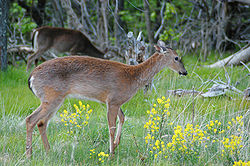
Mammals include White-tailed deer, black bear, beaver, bobcat, coyote, raccoon, skunk, groundhog, Virginia Opossum, gray fox, and eastern cottontail rabbit.[39] Birds include cardinals, barred owls, Carolina chickadees, Red-tailed Hawks, and Wild Turkeys. The Peregrine Falcon was reintroduced into Shenandoah National Park in the mid-1990s.[40] Walleye, brook trout, Roanoke bass, and blue catfish are among the 210 known species of freshwater fish.[41] Running brooks with rocky bottoms are often inhabited by a plentiful amounts of crayfish and salamanders.[26] The Chesapeake Bay is host to many species, including blue crabs, clams, oysters, and rockfish (also known as striped bass).[42]
Virginia has 30 National Park Service units, such as Great Falls Park and the Appalachian Trail, and one national park, the Shenandoah National Park.[43] Shenandoah was established in 1935 and encompasses the scenic Skyline Drive. Almost 40% of the park's area (79,579 acres/322 km2) has been designated as wilderness under the National Wilderness Preservation System.[44] Additionally, there are 34 Virginia state parks and 17 state forests, run by the Department of Conservation and Recreation and the Department of Forestry.[36][45] The Chesapeake Bay, while not a national park, is protected by both state and federal legislation, and the jointly run Chesapeake Bay Program which conducts restoration on the bay and its watershed. The Great Dismal Swamp National Wildlife Refuge extends into North Carolina.[46]
History
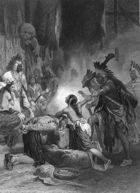
Jamestown 2007 marked Virginia's quadricentennial year, celebrating 400 years since the establishment of the Jamestown Colony. The far-reaching social changes of the mid- to late-20th century were expressed by broad-based celebrations marking contributions of three cultures to the state: Native American, European, and African.[47][48] These three groups have each had a significant part in shaping Virginia's history. Warfare has also had an important role, and Virginia has been a focus several conflicts from the American Revolution and the Civil War to the Cold War and the War on Terrorism.[49] Stories about historic figures, such as those surrounding Pocahontas and John Smith, George Washington's childhood, or the antebellum period, have also created potent myths of state history, and have served as rationales for Virginia's ideology.[50]
Colony
The first peoples are estimated to have arrived in Virginia over 12,000 years ago.[51] By 5,000 years ago more permanent settlements emerged, and farming began by 900 CE. By 1500, the Algonquian peoples had founded towns such as Werowocomoco in the Tidewater region, which they referred to as Tsenacommacah. The other major language groups in the area were the Siouan to the west, and the Iroquoians, who included the Nottoway and Meherrin, to the north and south. After 1570, the Algonquians consolidated under Chief Powhatan in response to threats from these other groups on their trade network.[52] Powhatan controlled more than 30 smaller tribes and over 150 settlements, who shared a common Virginia Algonquian language. In 1607, the native Tidewater population was between 13,000 to 14,000.[53]
In 1583, Queen Elizabeth I of England granted Walter Raleigh a charter to explore and plant a colony north of Spanish Florida.[54] In 1584, Raleigh sent an expedition to the Atlantic coast of North America.[55] The name "Virginia" may have been suggested by Raleigh or Elizabeth, perhaps noting her status as the "Virgin Queen", and may also be related to a native phrase, "Wingandacoa", or name, "Wingina".[56] Initially the name applied to the entire coastal region from South Carolina to Maine, plus the island of Bermuda.[57] The London Company was incorporated as a joint stock company by the proprietary Charter of 1606, which granted land rights to this area. The Company financed the first permanent English settlement in the "New World", Jamestown. Named for King James I, it was founded in May 1607 by Christopher Newport.[58] In 1619, colonists took greater control with an elected legislature called the House of Burgesses. With the bankruptcy of the London Company in 1624, the settlement was taken into royal authority as a British crown colony.[59]

Life in the colony was perilous, and many died during the "starving time" in 1609 and the Indian massacre of 1622, led by Opchanacanough.[60] By 1624, only 3,400 of the 6,000 early settlers had survived.[61] However, European demand for tobacco fueled the arrival of more settlers and servants.[62] African workers were first imported in 1619, and their slavery was codified after 1660. The headright system tried to solve the labor shortage by providing colonists with land for each indentured servant they transported to Virginia.[63] Tensions between the working and ruling classes led to Bacon's Rebellion in 1676, by when current and former indentured servants made up as much as 80% of the population.[64] Colonists appropriated land from Virginia Indians by force and treaty, including the Treaty of 1677, which made the signatory tribes tributary states. Williamsburg became the colonial capital in 1699, following the founding of The College of William & Mary in 1693.[65]
Statehood
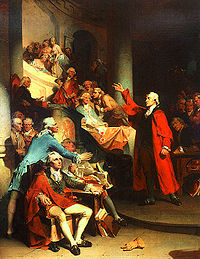
The British Parliament's efforts to levy new taxes following the French and Indian War (1754–1763) were deeply unpopular in the colonies. In the House of Burgesses, opposition to taxation without representation was led by Patrick Henry and Richard Henry Lee, among others.[66] Virginians began to coordinate their actions with other colonies in 1773, and sent delegates to the Continental Congress the following year.[67] After the House of Burgesses was dissolved by the royal governor in 1774, Virginia's revolutionary leaders continued to govern via the Virginia Conventions. On May 15, 1776, the Convention declared Virginia's independence from the British Empire and adopted George Mason's Virginia Declaration of Rights, which was then included in a new constitution.[68] Another Virginian, Thomas Jefferson, drew upon Mason's work in drafting the national Declaration of Independence.[69]
When the American Revolutionary War began, George Washington, who had commanded Virginia's forces in the French and Indian War, was selected to head the colonial army. During the war, the capital was moved to Richmond at the urging of Governor Thomas Jefferson, who feared that Williamsburg's location would make it vulnerable to British attack.[70] In 1781, the combined action of Continental and French land and naval forces trapped the British army on the Virginia Peninsula, where troops under George Washington and Comte de Rochambeau defeated British General Cornwallis in the Siege of Yorktown. His surrender on October 19, 1781, led to peace negotiations in Paris and secured the independence of the colonies.[71]
Virginians were instrumental in writing the United States Constitution. James Madison drafted the Virginia Plan in 1787 and the Bill of Rights in 1789.[69] Virginia ratified the Constitution on June 25, 1788. The three-fifths compromise ensured that Virginia, with its large number of slaves, initially had the largest bloc in the House of Representatives. Together with the Virginia dynasty of presidents, this gave the Commonwealth national importance. In 1790, both Virginia and Maryland ceded territory to form the new District of Columbia, though in 1846 the Virginian area was retroceded.[72] Virginia is sometimes called "Mother of States" because of its role in being carved into several mid-western states.[73]
Civil War and aftermath
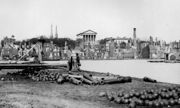
In addition to agriculture, slave labor was increasingly used in mining, shipbuilding and other industries.[74] After the Revolutionary War, the free black population rose, creating thriving communities in Petersburg and Richmond. Numerous individual manumissions were inspired by Quaker abolitionists and the revolution's principles.[75] Nat Turner's slave rebellion in 1831 and John Brown's Raid on Harpers Ferry in 1859 showed deep social discontent about slavery and its role in the plantation economy. By 1860, almost half a million people, roughly 31% of the total population of Virginia, were enslaved.[76] This division contributed to the start of the American Civil War.
Virginia voted to secede from the United States on April 17, 1861, after the Battle of Fort Sumter and Abraham Lincoln's call for volunteers. On April 24, Virginia joined the Confederate States of America, which chose Richmond as its capital.[73] After the 1863 Wheeling Convention, 48 counties in the northwest separated to form a new state of West Virginia, which chose to remain loyal to the Union. During the war, more battles were fought in Virginia than anywhere else, including Bull Run, the Seven Days Battles, Chancellorsville, and the concluding Battle of Appomattox Court House.[77] After the capture of Richmond in 1865, the capital was briefly moved to Danville.[78] Virginia was formally restored to the United States in 1870, due to the work of the Committee of Nine.[79]
During the post-war Reconstruction era, Virginia adopted a constitution which provided for free public schools, and guaranteed political, civil, and voting rights.[80] The populist Readjuster Party ran an inclusive coalition until the conservative white Democratic Party gained power after 1883.[81] It passed segregationist Jim Crow laws and in 1902 rewrote the Constitution of Virginia to include a poll tax and other voter registration measures that effectively disfranchised most African Americans and many poor whites.[82] Despite underfunding for segregated schools and services and a lack of political representation, African Americans still created vibrant communities and made progress.[83]
Modern times
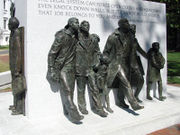
Protests started by Barbara Rose Johns in 1951 in Farmville against segregated schools led to the lawsuit Davis v. County School Board of Prince Edward County. This case, filed by Richmond natives Spottswood Robinson and Oliver Hill, was decided in 1954 with Brown v. Board of Education, which rejected the segregationist doctrine of "separate but equal". However in 1958, under the policy of "massive resistance" spearheaded by the influential segregationist Senator Harry F. Byrd and his Byrd Organization, the state prohibited desegregated local schools from receiving funding.[84]
The Civil Rights Movement gained many participants in the 1960s and achieved the moral force to gain national legislation for protection of suffrage and civil rights for African Americans. In 1964 the United States Supreme Court ordered Prince Edward County and others to integrate schools.[85] In 1967, the Court also struck down the state's ban on interracial marriage. From 1969 to 1971, state legislators under Governor Mills Godwin rewrote the constitution, after goals such as the repeal of Jim Crow laws had been achieved. In 1989, Douglas Wilder became the first African American elected as governor in the United States.[86]
New economic forces also changed the Commonwealth. In 1926, Dr. W.A.R. Goodwin, rector of Williamsburg's Bruton Parish Church, began restoration of colonial-era buildings in the historic district with financial backing of John D. Rockefeller, Jr.; their work led to the development of Colonial Williamsburg, the state's most popular tourism site.[87] World War II and the Cold War led to massive expansion of national government programs housed in offices in Northern Virginia near Washington, D.C., and correlative population growth.[88] Among the federal developments was the Pentagon, which was later targeted in the September 11 attacks, during which 189 people died.[89]
Cities and towns
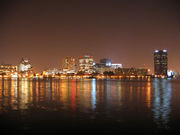
Virginia is divided into 95 counties and 39 independent cities, which both operate the same way since independent cities are considered to be county-equivalent.[90] This method of treating cities and counties equally is unique to Virginia, with only three other independent cities in the United States outside Virginia.[91] While incorporation as a city constitutes independence (since 1871), there are also incorporated towns which operate under their own governments but are part of a county, too. Finally there are hundreds of unincorporated communities within the counties. Virginia does not have any further political subdivisions, such as villages or townships.
Virginia has 11 Metropolitan Statistical Areas; Northern Virginia, Hampton Roads, and Richmond-Petersburg are the three most populous. Richmond is the capital of Virginia, and its metropolitan area has a population of over 1.2 million.[92] As of 2008[update], Virginia Beach is the most populous city in the Commonwealth, with Norfolk and Chesapeake second and third, respectively.[93] Norfolk forms the urban core of the Hampton Roads metropolitan area, which has a population over 1.6 million people and is the site of the world's largest naval base, Naval Station Norfolk.[92][94] Suffolk, which includes a portion of the Great Dismal Swamp, is the largest city by area at 429.1 square miles (1,111 km2).[95]
Fairfax County is the most populous division in Virginia, with over one million residents, although that does not include its county seat Fairfax, which is one of the independent cities.[96] Fairfax County has a major urban business and shopping center in Tysons Corner, Virginia's largest office market.[97] Neighboring Loudoun County, with the county seat at Leesburg, is both the fastest-growing county in the United States and has the highest median household income ($107,207) as of 2007[update].[98][99] Arlington County, the smallest self-governing county in the United States by land area, is an urban community organized as a county.[100] The Roanoke area, with a population of 292,983, is the largest Metropolitan Statistical Area in western Virginia.[101]
Demographics
| Historical populations | |||
|---|---|---|---|
| Census | Pop. | %± | |
| 1790 | 691,737 |
|
|
| 1800 | 807,557 | 16.7% | |
| 1810 | 877,683 | 8.7% | |
| 1820 | 938,261 | 6.9% | |
| 1830 | 1,044,054 | 11.3% | |
| 1840 | 1,025,227 | −1.8% | |
| 1850 | 1,119,348 | 9.2% | |
| 1860 | 1,219,630 | 9.0% | |
| 1870 | 1,225,163 | 0.5% | |
| 1880 | 1,512,565 | 23.5% | |
| 1890 | 1,655,980 | 9.5% | |
| 1900 | 1,854,184 | 12.0% | |
| 1910 | 2,061,612 | 11.2% | |
| 1920 | 2,309,187 | 12.0% | |
| 1930 | 2,421,851 | 4.9% | |
| 1940 | 2,677,773 | 10.6% | |
| 1950 | 3,318,680 | 23.9% | |
| 1960 | 3,966,949 | 19.5% | |
| 1970 | 4,648,494 | 17.2% | |
| 1980 | 5,346,818 | 15.0% | |
| 1990 | 6,187,358 | 15.7% | |
| 2000 | 7,078,515 | 14.4% | |
| Est. 2009 | 7,882,590 | 11.4% | |

Virginia has metropolitan areas located throughout the state.
|
As of 2008[update], Virginia had an estimated population of 7,769,089 which is an increase of 56,998, or about 1%, from the prior year and an increase of 690,574, or 9.8%, since the year 2000.[5] This includes an increase from net migration of 314,832 people into the Commonwealth. Immigration from outside the United States resulted in a net increase of 159,627 people, and migration within the country produced a net increase of 155,205 people.[102] The center of population is located in Goochland County outside of Richmond.[103]
English was passed as the Commonwealth's official language by statutes in 1981 and again in 1996, though the status is not mandated by the Constitution of Virginia.[104] English is the only language spoken by 6,245,517 (86.7%) Virginians, though it is spoken "very well" by an additional 570,638 (7.9%) for a total of 94.6% of the Commonwealth. Among speakers of other languages Spanish is the most common with 424,381 (5.9%). 226,911 (3.2%) speak Asian and Pacific Islander languages, including Korean, Vietnamese, and Filipino.[105]
Ethnicity
As of 2000[update], the five largest reported ancestry groups in Virginia are: African (19.6%), German (11.7%), unspecified American (11.4%), English (11.1%), and Irish (9.8%).[106] Most Virginians who self-identify as having "American" ancestry are actually of predominantly English descent, but have ancestry that has been in North America for so long, in many cases since the early seventeenth century, that they choose to identify simply as "American".[107][108]
Because of more recent immigration in the late 20th century and early 21st century, there are growing populations of Hispanics, particularly Central Americans, and Asians. As of 2007[update], 6.6% of Virginians are Hispanic, 5.4% are Asian, and 0.9% are American Indian/Alaska Native/Native Hawaiian/Pacific Islander.[5] The Hispanic population of the state tripled from 1990 to 2006, with two-thirds of Hispanics living in Northern Virginia. Hispanics in Virginia have higher median household incomes and educational attainment than the general United States or Virginia population.[109]
Most African American Virginians are descendants of enslaved Africans who worked on tobacco, cotton, and hemp plantations. These men, women and children were brought from west-central Africa, primarily from Angola and the Bight of Biafra. The Igbo ethnic group of what is now southern Nigeria were the single largest African group among slaves in Virginia.[110][111] Though the black population was reduced by the Great Migration, since 1965 there has been a reverse migration of blacks returning south.[112] The western mountains have many settlements founded by English and Scotch-Irish immigrants before the Revolution.[113] There are also sizable numbers of people of German descent in the northwestern mountains and Shenandoah Valley.[114] People of English heritage settled throughout the state during the colonial period, and others of British and Irish heritage have since immigrated to the state for work.[115]
Northern Virginia has some of the largest populations nationwide of Vietnamese Americans, whose major wave of immigration followed the Vietnam War, and Korean Americans, whose migration has been more recent and was induced in part by the quality school system.[116][117] The Filipino American community has about 45,000 in the Hampton Roads area, many of whom have ties to the U.S. Navy and armed forces.[118] Virginia has extended state recognition to eight Native American tribes resident in the state, though all lack federal recognition status. Most Native American groups are located in the Tidewater region.[119]
|
|||||||||||||||||||||||||||||||||
Religion
| Religion (2008) | ||
|---|---|---|
| Christian[120] | 76% | |
| Baptist | 27% | |
| Roman Catholic | 11% | |
| Methodist | 8% | |
| Lutheran | 2% | |
| Other Christian | 28% | |
| Buddhism | 1% | |
| Hinduism | 1% | |
| Judaism | 1% | |
| Islam | 0.5% | |
| Unaffiliated | 18% | |
Virginia is predominantly Christian and Protestant; Baptists are the largest single group with 27% of the population as of 2008[update].[120] Baptist denominational groups in Virginia include the Baptist General Association of Virginia, with about 1,400 member churches, which supports both the Southern Baptist Convention and the moderate Cooperative Baptist Fellowship; and the Southern Baptist Conservatives of Virginia with more than 500 affiliated churches, which supports the Southern Baptist Convention.[121][122] Roman Catholics are the second-largest religious group, and the group which grew the most in the 1990s.[123][124] The Roman Catholic Diocese of Arlington includes most of Northern Virginia's Catholic churches, while the Diocese of Richmond covers the rest.
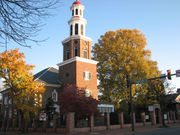
The Virginia Conference is the regional body of the United Methodist Church and the Virginia Synod is responsible for the congregations of the Lutheran Church. Presbyterians, Pentecostals, Congregationalists, and Episcopalians each composed 1–3% of the population as of 2001[update].[125] The Episcopal Diocese of Virginia, Southern Virginia, and Southwestern Virginia support the various Episcopal churches.
In November 2006, 15 conservative Episcopal churches voted to split from the Diocese of Virginia over the ordination of openly gay bishops and clergy in other dioceses of the Episcopal Church; these churches continue to claim affiliation with the larger Anglican Communion through other bodies outside the United States. Though Virginia law allows parishioners to determine their church's affiliation, the diocese claims the secessionist churches' properties. The resulting property law case is a test for Episcopal churches nationwide.[126]
Among other religions, adherents of The Church of Jesus Christ of Latter-day Saints constitute 1.1% of the population, with 188 congregations in Virginia as of 2008[update].[127] Fairfax Station is the site of the Ekoji Buddhist Temple, of the Jodo Shinshu school, and the Hindu Durga Temple. While the state's Jewish population is small, organized Jewish sites date to 1789 with Congregation Beth Ahabah.[128] Muslims are a growing religious group throughout the state through immigration.[129] Megachurches in the state include Thomas Road Baptist Church, Immanuel Bible Church, and McLean Bible Church.[130] Several Christian universities are also based in the state, including Regent University, Liberty University, and Lynchburg College.
Economy
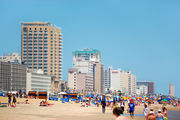
Virginia's economy is balanced, with diverse sources of income, including government and military, farming, and business. Virginia has 4.1 million civilian workers, and one-third of the jobs are in the service sector.[131][132] The unemployment rate is 7.2% as of February 2010[update].[133] In 2009, Forbes Magazine named Virginia the best state in the nation for business for the fourth year in a row.[134] The Gross Domestic Product of Virginia was $397 billion in 2008.[135] As of 2000[update], Virginia had the highest number of counties in the top 100 wealthiest jurisdictions in the United States based upon median income.[136] Virginia has 18 Fortune 500 companies, ranking the state tenth nationwide.[137]
Virginia has the highest concentration of technology workers of any state.[138] Computer chips became the state's highest-grossing export in 2006, surpassing its traditional top exports of coal and tobacco combined.[8] Northern Virginia, once considered the state's dairy capital, now hosts software, communication technology, and consulting companies, particularly in the Dulles Technology Corridor. Northern Virginia's data centers currently carry more than 50% of the nation's internet traffic, and by 2012 Dominion Power expects that 10% of all its electricity in Northern Virginia will be used by data centers.[139] Loudoun and Fairfax counties in Northern Virginia have the highest and second highest median household income, respectively, of all counties in the United States as of 2006[update].[140]
Agriculture occupies 24% of the land in Virginia. As of 2007[update], about 357,000 Virginian jobs were in agriculture, with over 47,000 farms, averaging 171 acres (0.27 sq mi; 0.69 km2), in a total farmland area of 8.1 million acres (12,656 sq mi; 32,780 km2). Though agriculture has declined significantly since 1960 when there were twice as many farms, it remains the largest single industry in Virginia.[141] Tomatoes surpassed soy as the most profitable crop in Virginia in 2006, with peanuts and hay as other agricultural products.[142] Though its no longer the primary crop, Virginia is still the fifth-largest producer of tobacco nationwide.[143] Eastern oyster harvests are an important part of the Chesapeake Bay economy, but declining oyster populations from disease, pollution, and overfishing have diminished catches.[144] Wineries and vineyards in the Northern Neck and along the Blue Ridge Mountains also have begun to generate income and attract tourists.[145]

10% of all U.S. federal procurement money is spent in Virginia.[147] Virginia has the highest defense spending of any state per capita, providing the state with around 900,000 jobs.[147][148] Virginia has over 800,000 veterans, more than any other state, and is second to California in total Department of Defense employees.[149][148] Many Virginians work for federal agencies in Northern Virginia, which include the Central Intelligence Agency and the Department of Defense, as well as the National Science Foundation, the United States Geological Survey and the United States Patent and Trademark Office. Many others work for government contractors, including defense and security firms, which hold more than 15,000 federal contracts.[150] The Hampton Roads area has the largest concentration of military bases and facilities of any metropolitan area in the world. The largest of the bases is Naval Station Norfolk.[94]
Virginia collects personal income tax in five income brackets, ranging from 3.0% to 5.75%. The state sales and use tax rate is 4%, while the tax rate on food is 1.5%. There is an additional 1% local tax, for a total of a 5% combined sales tax on most Virginia purchases and 2.5% on most food.[151] Virginia's property tax is set and collected at the local government level and varies throughout the Commonwealth. Real estate is also taxed at the local level based on 100% of fair market value. Tangible personal property also is taxed at the local level and is based on a percentage or percentages of original cost.[152]
Culture
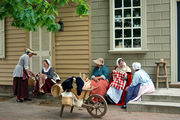
Virginia's historic culture was popularized and spread across America and the South by figures such as George Washington, Thomas Jefferson, and Robert E. Lee. Their homes in Virginia represent the birthplace of America and the South. Modern Virginia culture has many sources, and is part of the culture of the Southern United States.[153][154] The Smithsonian Institution divides Virginia into nine cultural regions.[155] The Piedmont region is one of the most famous for its dialect's strong influence on Southern American English. While a more homogenized American English is found in urban areas, various accents are also used, including the Tidewater accent, the Old Virginia accent, and the anachronistic Elizabethan of Tangier Island.[156][157]
Literature in Virginia often deals with the state's extensive, and sometimes troubled, past. The works of Pulitzer Prize winner Ellen Glasgow often dealt with social inequalities and the role of women in her culture.[158] Glasgow's peer and close friend James Branch Cabell wrote extensively about the changing position of gentry in the Reconstruction era, and challenged its moral code with Jurgen, A Comedy of Justice.[159] William Styron approached history in works such as The Confessions of Nat Turner and Sophie's Choice.[160] Tom Wolfe has occasionally dealt with his southern heritage in bestsellers like I Am Charlotte Simmons.[161] Virginia also names a state Poet Laureate, currently Claudia Emerson of Fredericksburg who will serve until 2010.[162]
Besides the general cuisine of the Southern United States, Virginia maintains its own particular traditions. Virginia wine is made in many parts of the state.[145] Smithfield ham, sometimes called "Virginia ham", is a type of country ham which is protected by state law, and can only be produced in the town of Smithfield.[163] Virginia furniture and architecture are typical of American colonial architecture. Thomas Jefferson and many of the state's early leaders favored the Neoclassical architecture style, leading to its use for important state buildings. The Pennsylvania Dutch and their style can also be found in parts of the state.[114]
Fine and performing arts
_meadow_pavilion.jpg)
Though rich in cultural heritage, Virginia ranks near the bottom of U.S. states in terms of public spending on the arts, at nearly half of the national average.[164] The state does fund institutions including the Virginia Museum of Fine Arts and the Science Museum of Virginia. Other museums include the popular Steven F. Udvar-Hazy Center of the National Air and Space Museum and the Chrysler Museum of Art.[165] Besides these sites, many open-air museums are located in the state, such as Colonial Williamsburg, the Frontier Culture Museum, and various historic battlefields.[166] The Virginia Foundation for the Humanities works to improve the Commonwealth's civic, cultural, and intellectual life.[167]
Theaters and venues in the state are found both in the cities and suburbs. Wolf Trap National Park for the Performing Arts is located in Vienna and is the only national park intended for use as a performing arts center.[168] The Harrison Opera House, in Norfolk, is the official Virginia Opera. The Virginia Symphony Orchestra operates around Hampton Roads.[169] Resident and touring theater troupes operate from the American Shakespeare Center in Staunton.[170] The Barter Theatre in Abingdon won the first ever Regional Theatre Tony Award in 1948, while the Signature Theatre in Arlington won it in 2009. There's also a Children's Theater of Virginia, Theatre IV, which is the second largest touring troupe nationwide.[171] Virginia has launched many award-winning traditional musical artists and internationally successful popular music acts, as well as Hollywood actors.[1] Notable performance venues include The Birchmere, the Landmark Theater, and Jiffy Lube Live.[172]
Festivals

Many counties and localities host county fairs and festivals. The Virginia State Fair is held at the Meadow Event Park every September. Also in September is the Neptune Festival in Virginia Beach, which celebrates the city, the waterfront, and regional artists. Norfolk's Harborfest, in June, features boat racing and air shows.[173] Fairfax County also sponsors Celebrate Fairfax! with popular and traditional music performances.[174] The Virginia Lake Festival is held during the third weekend in July in Clarksville.[175] Wolf Trap hosts the Wolf Trap Opera Company, which produces an opera festival every summer.[168]
On the Eastern Shore island of Chincoteague the annual Pony Swim & Auction of feral Chincoteague ponies at the end of July is a unique local tradition expanded into a week-long carnival. The Shenandoah Apple Blossom Festival is a six-day festival held annually in Winchester that includes parades and bluegrass concerts. The Old Time Fiddlers' Convention in Galax, begun in 1935, is one of the oldest and largest such events worldwide. Two important film festivals, the Virginia Film Festival and the VCU French Film Festival, are held annually in Charlottesville and Richmond, respectively.[173]
Media
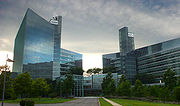
The Hampton Roads area is the 42nd-largest media market in the United States as ranked by Nielsen Media Research, while the Richmond-Petersburg area is 60th and Roanoke-Lynchburg is 68th.[176] There are 21 television stations in Virginia, representing each major U.S. network, part of 42 stations which serve Virginia viewers.[177] More than 800 FCC-licensed FM radio stations broadcast in Virginia, with over 300 such AM stations.[178][179] The nationally available Public Broadcasting Service (PBS) is headquartered in Arlington. The locally focused Commonwealth Public Broadcasting Corporation, which produces MHz Networks, is a non-profit corporation which owns public TV and radio stations and has offices around the state.[180]
The most circulated native newspapers in the Commonwealth are the Richmond Times-Dispatch, Norfolk's The Virginian-Pilot, The Roanoke Times, and Newport News' Daily Press. As of 2008[update], the Pilot has a daily subscription of 174,573, slightly more than the Times-Dispatch at 160,886, 54th and 59th in the nation respectively, while the Roanoke Times has about 90,557 daily subscribers.[181][182] Several Washington, D.C. papers are based in Northern Virginia, such as The Washington Examiner and The Politico. The paper with the nation's widest circulation, USA Today, is headquartered in McLean.[183] Besides traditional forms of media, Virginia is the home base for telecommunication companies such as Sprint Nextel and XO Communications.
Education
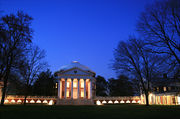
Virginia's educational system consistently ranks in the top ten states on the U.S. Department of Education's National Assessment of Educational Progress, with Virginia students outperforming the average in all subject areas and grade levels tested.[185] The 2010 Quality Counts report ranked Virginia's K–12 education fourth best in the country.[186] All school divisions must adhere to educational standards set forth by the Virginia Department of Education, which maintains an assessment and accreditation regime known as the Standards of Learning to ensure accountability.[187] In 2008, 81% of high school students graduated on-time after four years.[188] Between 2000 and 2008, school enrollment increased 5%, the number of teachers 21%.[189]
Public K–12 schools in Virginia are generally operated by the counties and cities, and not by the state. As of April 2010[update], a total of 1,259,623 students were enrolled in 1,881 local and regional schools in the Commonwealth, including three charter schools, and an additional 109 alternative and special education centers across 132 school divisions.[190][191] Besides the general public schools in Virginia, there are Governor's Schools and selective magnet schools. The Governor's Schools are a collection of more than 40 regional high schools and summer programs intended for gifted students.[192] The Virginia Council for Private Education oversees the regulation of 294 state accredited and 141 non-accredited private schools.[193] An additional 7,020 students receive homeschooling.[194]
As of 2010[update], there are 167 colleges and universities in Virginia.[195] In the U.S. News and World Report ranking of public colleges, the University of Virginia is second and The College of William & Mary is sixth.[196][197] Virginia Commonwealth University is ranked the top public graduate school in fine arts, while James Madison University has been recognized as the top public master's program in The South since 1993.[198][199] The Virginia Military Institute is the oldest state military college and a top ranked public liberal arts college.[200][201] George Mason University is the largest university in Virginia with over 32,000 students.[202] Virginia Tech and Virginia State University are the state's land-grant universities. Virginia also operates 23 community colleges on 40 campuses serving over 260,000 students.[203] There are 120 private institutions, including Washington and Lee University, Hampden–Sydney College, Roanoke College, and the University of Richmond.[195]
Health
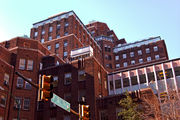
Virginia has a mixed health record, and is ranked as the 21st overall healthiest state according to the 2009 United Health Foundation's Health Rankings.[204] Virginia also ranks 21st among the states in the rate of premature deaths, 7,104 per 100,000. In 2008, Virginia reached its lowest ever rate of infant mortality, at 6.7 deaths per 1,000.[205] There are however racial and social health disparities, with African Americans experiencing 27.9% more premature deaths than whites, while 13.6% of Virginians lack any health insurance.[204] According to the Centers for Disease Control and Prevention's 2007 survey, 25.3% of Virginians are obese and another 36.6% are overweight, and only 78.4% of residents exercise regularly.[206][207] About 30% of Virginia's 10- to 17-year-olds are overweight or obese.[208]
There are 85 hospitals in Virginia listed with the United States Department of Health and Human Services.[209] Notable examples include Inova Fairfax Hospital, the largest hospital in the Washington Metropolitan Area, and the VCU Medical Center, located on the medical campus of Virginia Commonwealth University. The University of Virginia Medical Center, part of the University of Virginia Health System, is highly ranked in endocrinology according to U.S.News & World Report.[210] Sentara Norfolk General Hospital, part of the Hampton Roads based Sentara Health System and a teaching institution of Eastern Virginia Medical School, was the site of the first successful in-vitro fertilization birth.[211][212] Virginia has a ratio of 124 primary care physicians per 10,000 residents, which is the 13th highest nationally.[204] Virginia was one of five states to receive a perfect score in disaster preparedness according to a 2008 report by the Trust for America's Health, based on criteria such as detecting pathogens and distributing vaccines and medical supplies.[213]
In 2010, Virginia enacted stringent limitations on the use of state funds to provide abortions or to support abortion clinics, except in cases of rape, incest, or in situations where the mother's health is in danger.[214] Although the General Assembly has failed to adopt bills that would require hospital-like regulation of clinics that perform first trimester abortions, Attorney General Ken Cuccinelli has issued an opinion letter empowering the Virginia Board of Health to conduct such regulation.[215]
Transportation
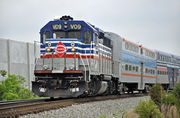
Because of the 1932 Byrd Road Act, the state government controls most of Virginia's roads, instead of a local city or county authority as is usual in other states.[216] As of 2007[update], the Virginia Department of Transportation owns and operates 57,867 miles (93,128 km) of the total 68,428 miles (110,124 km) of roads in the state, making it the third largest state highway system in the United States.[217] Virginia's road system is ranked as the 16th best in the nation.[218] While the Washington Metropolitan Area has the second worst traffic in the nation, Virginia as a whole has the 21st-lowest congestion and the average commute time is 26.9 minutes.[219][220] Virginia has both low disbursements for roads and bridges, and a low road fatality rate.[218]
Virginia has Amtrak passenger rail service along several corridors, and Virginia Railway Express maintains two commuter lines into Washington, D.C. from Fredericksburg and Manassas. The Washington Metro rapid transit system serves Northern Virginia as far west as Fairfax County, although expansion plans call for Metro to reach Loudoun County by 2016.[221] Commuter buses include the Fairfax Connector and the Shenandoah Valley Commuter Bus. The Virginia Department of Transportation operates several free ferries throughout Virginia, the most notable being the Jamestown-Scotland ferry which crosses the James River in Surry County.[222]
Virginia has five major airports: Washington Dulles International, Reagan Washington National, Norfolk International, Richmond International, and Newport News/Williamsburg International Airport. Sixty-six public airports serve the state's aviation needs.[223] The Virginia Port Authority's main seaports are those in Hampton Roads, which carried 17,726,251 short tons (16,080,984 t) of bulk cargo in 2007, the sixth most of United States ports.[224] The Eastern Shore of Virginia is the site of Wallops Flight Facility, a rocket testing center owned by NASA, and the Mid-Atlantic Regional Spaceport, a commercial spaceport.[225][226] Space tourism is also offered through Vienna-based Space Adventures.[227]
Law and government
In colonial Virginia, free men elected the lower house of the legislature, called the House of Burgesses, which together with the Governor's Council, made the "General Assembly". Founded in 1619, the Virginia General Assembly is still in existence as the oldest legislature in the Western Hemisphere.[228] The modern government is ranked by the Pew Center on the States with an A− in terms of its efficiency, effectiveness, and infrastructure. This is the second time Virginia received the highest grade in the nation, which it shares with two others.[7]
Since 1971, the government has functioned under the seventh Constitution of Virginia, which provides for a strong legislature and a unified judicial system. Similar to the federal structure, the government is divided in three branches: legislative, executive, and judicial. The legislature is the General Assembly, a bicameral body whose 100-member House of Delegates and 40-member Senate write the laws for the Commonwealth. The Assembly is stronger than the executive, as it selects judges and justices. The Governor and Lieutenant Governor are elected every four years in separate elections. Incumbent governors cannot run for re-election, however the Lieutenant Governor and Attorney General can, and governors may serve non-consecutive terms.[229] The judicial system, the oldest in America, consists of a hierarchy from the Supreme Court of Virginia and the Court of Appeals of Virginia to the lower general district and circuit courts.[230]
The Code of Virginia is the statutory law, and consists of the codified legislation of the General Assembly. The Virginia State Police is the largest law enforcement agency in Virginia. The Virginia Capitol Police are the oldest police department in the United States.[231] The Virginia National Guard consists of 7,500 soldiers in the Virginia Army National Guard and 1,200 airmen in the Virginia Air National Guard.[232] Since the 1982 resumption of capital punishment in Virginia, 107 people have been executed, the second highest number in the nation.[233] The "total crime risk" is 28% lower than the national average.[234]
Politics
In the last century Virginia has shifted from a largely rural, politically Southern and conservative state to a more urbanized, pluralistic, and politically moderate environment. Up until the 1970s, Virginia was a racially divided single-party state dominated by the Byrd Organization.[235] African Americans were effectively disfranchised until after passage of civil rights legislation in the mid-1960s.[236] Enfranchisement and immigration of other groups, especially Hispanics, have placed growing importance on minority voting.[237] Regional differences play a large part in Virginia politics.[238] Rural southern and western areas moved to support the Republican Party in response to its "southern strategy", while urban and growing suburban areas, including much of Northern Virginia, form the Democratic Party base.[239][240] Democratic support also persists in union-influenced parts of Southwest Virginia, college towns such as Charlottesville and Blacksburg, and the southeastern Black Belt Region.[241]

Political party strength in Virginia has likewise been in flux. In the 2007 state elections, Democrats regained control of the State Senate, and narrowed the Republican majority in the House of Delegates to eight seats.[242] Yet elections in 2009 resulted in the election of Republican Robert McDonnell as governor by a 17 point margin, the election of a Republican Lieutenant Governor and Attorney General, as well as Republican gains of six seats in the House of Delegates.[243] State election seasons traditionally start with the annual Shad Planking event in Wakefield.[244]
In federal elections since 2006, Democrats have seen more success. In the 2006 Senate election, Democrat Jim Webb won on a populist platform over the Republican incumbent following a very close race.[245] The party took both U.S. Senate seats after 2008, when former Governor Mark Warner replaced retiring Republican John Warner.[246] Of the state's 11 seats in the U.S. House of Representatives, Democrats hold six and Republicans hold five. Virginia, which has 13 electoral votes, was won by Democrat Barack Obama in 2008, after being won by Republican candidates in the previous ten presidential elections.[247] Virginia may be considered a "swing state" in future presidential elections.[6]
Sports

Virginia is the most populous U.S. state without a major professional sports league franchise.[249] The reasons for this include the lack of any dominant city or market within the state and the proximity of teams in Washington, D.C.[250] Virginia has several minor league clubs, especially in baseball and soccer. Additionally, the Washington Redskins have Redskins Park, their headquarters and training facility, in Ashburn and the Washington Capitals train at Kettler Capitals Iceplex in Ballston.[251] Virginia has many professional caliber golf courses including the Greg Norman course at Lansdowne Resort and Kingsmill Resort, home of the Michelob ULTRA Open. NASCAR currently schedules Sprint Cup races on two tracks in Virginia: Martinsville Speedway and Richmond International Raceway. Current Virginia drivers in the series include Jeff Burton, Denny Hamlin, and Elliot Sadler.[252]
The Washington Nationals and Baltimore Orioles also have followings due to their proximity, and both are broadcast in the state on MASN.[253] When the New York Mets ended their long affiliation with the Norfolk Tides in 2007, the Orioles adopted the minor league club as their top level (AAA) minor league affiliate.[254] The San Francisco Giants' AA team, the Richmond Flying Squirrels, began play at The Diamond in 2010, replacing the AAA Richmond Braves, who relocated after 2008.[255] Additionally, the Nationals, Orioles, Pittsburgh Pirates, Boston Red Sox, Seattle Mariners, Chicago White Sox, and Atlanta Braves also have Single-A and Rookie-level farm teams in Virginia.[256]
Virginia does not allow state appropriated funds to be used for either operational or capital expenses for intercollegiate athletics.[257] Despite this, both the Virginia Cavaliers and Virginia Tech Hokies have been able to field competitive teams in the Atlantic Coast Conference and maintain modern facilities. Their rivalry is followed statewide. Several other universities compete in NCAA Division I, particularly in the Colonial Athletic Association. Three historically black schools compete in the Division II Central Intercollegiate Athletic Association, and two others compete in the Division I Mid-Eastern Athletic Conference. Several smaller schools compete in the Old Dominion Athletic Conference and the USA South Athletic Conference of NCAA Division III. The NCAA currently holds its Division III championships in football, men's basketball, volleyball and softball in Salem.[258]
State symbols
The state nickname is its oldest symbol, though it has never been made official by law. Virginia was given the title "Dominion" by King Charles II of England at the time of The Restoration, because it had remained loyal to the crown during the English Civil War, and the present moniker, "Old Dominion" is a reference to that title. The other nickname, "Mother of Presidents", is also historic, as eight Virginians have served as President of the United States, including four of the first five.[1]
The state's motto, Sic Semper Tyrannis, translates from Latin as "Thus Always To Tyrants", and is used on the state seal, which is then used on the flag. While the seal was designed in 1776, and the flag was first used in the 1830s, both were made official in 1930.[1] The majority of the other symbols were made official in the late 20th century.[259] The Virginia reel is among the square dances classified as the state dance.[15] Virginia currently has no state song. In 1940, Virginia made "Carry Me Back to Old Virginny" the state song, but it was retired in 1997 and reclassified as the state song emeritus.[260] Various alternatives, including a version of "Oh Shenandoah", have met with resistance in the Virginia House of Delegates.[261]
|
|
See also
- Outline of Virginia
- Index of Virginia-related articles
References
- ↑ 1.0 1.1 1.2 1.3 "Factpack" (PDF). Virginia General Assembly. January 11, 2007. http://legis.state.va.us/1_cap_class/class_media/4_5_pdfs/factpack-1.pdf. Retrieved October 14, 2008.
- ↑ "Annual Estimates of the Resident Population for the United States, Regions, States, and Puerto Rico: April 1, 2000 to July 1, 2009". United States Census Bureau. http://www.census.gov/popest/states/tables/NST-EST2009-01.csv. Retrieved January 4, 2010.
- ↑ "Median household income in the past 12 months (in 2007 inflation-adjusted dollars)". American Community Survey. United States Census Bureau. 2007. http://factfinder.census.gov/servlet/STTable?_bm=y&-geo_id=04000US51&-qr_name=ACS_2008_3YR_G00_S1901&-ds_name=ACS_2008_3YR_G00_. Retrieved September 2, 2008.
- ↑ 4.0 4.1 "Elevations and Distances in the United States". U.S Geological Survey. April 29, 2005. http://egsc.usgs.gov/isb/pubs/booklets/elvadist/elvadist.html#Highest. Retrieved November 9, 2006.
- ↑ 5.0 5.1 5.2 "Virginia ACS Demographic and Housing Estimates: 2006-2008". United States Census Bureau. 2008. http://factfinder.census.gov/servlet/ADPTable?_bm=y&-geo_id=04000US51&-qr_name=ACS_2008_3YR_G00_DP3YR5&-ds_name=ACS_2008_3YR_G00_&-_lang=en. Retrieved October 31, 2009.
- ↑ 6.0 6.1 Balz, Dan (October 12, 2007). "Painting America Purple". The Washington Post. http://blog.washingtonpost.com/44/2007/10/12/the_purpling_of_america.html. Retrieved November 24, 2007.
- ↑ 7.0 7.1 Somashekhar, Sandhya (March 4, 2008). "Government Takes Top Honors in Efficiency". The Washington Post. http://www.washingtonpost.com/wp-dyn/content/story/2008/03/03/ST2008030303550.html. Retrieved March 11, 2008.
- ↑ 8.0 8.1 Richards, Gregory (February 24, 2007). "Computer chips now lead Virginia exports". The Virginian-Pilot. Archived from the original on 2007-03-10. http://web.archive.org/web/20070310155937/http://content.hamptonroads.com/story.cfm?story=120082&ran=25886. Retrieved September 29, 2008.
- ↑ "2000 Census of Population and Housing" (PDF). United States Census Bureau. April 2004. p. 71. http://www.census.gov/prod/cen2000/phc3-us-pt1.pdf. Retrieved November 3, 2009.
- ↑ "Supreme Court Rules for Virginia in Potomac Conflict". The Sea Grant Law Center. University of Mississippi. 2003. http://nsglc.olemiss.edu/SandBar/SandBar2/2.4supreme.htm. Retrieved November 24, 2007.
- ↑ Hubbard, Jr. 2009, p. 140
- ↑ "Fact Sheet 102-98 - The Chesapeake Bay: Geologic Product of Rising Sea Level". United States Geological Survey. November 18, 1998. http://pubs.usgs.gov/fs/fs102-98/. Retrieved August 24, 2009.
- ↑ Burnham & Burnham 2004, pp. 7, 56−57
- ↑ "Rivers and Watersheds". The Geology of Virginia. College of William and Mary. February 23, 2007. http://web.wm.edu/geology/virginia/rivers/rivers.html. Retrieved April 11, 2008.
- ↑ 15.0 15.1 The Encyclopedia of Virginia 1999, pp. 2–15
- ↑ Pazzaglia 2006, pp. 135−138
- ↑ "Virginia's Agricultural Resources". Natural Resource Education Guide. Virginia Department of Environmental Quality. January 21, 2008. http://www.deq.state.va.us/vanaturally/guide/agriculture.html. Retrieved February 8, 2008.
- ↑ Burnham & Burnham 2004, p. 277
- ↑ "Physiographic Regions of Virginia". The Geology of Virginia. College of William and Mary. February 16, 2007. http://web.wm.edu/geology/virginia/provinces/phys_regions.html. Retrieved April 7, 2008.
- ↑ Palmer 1998, pp. 49−51
- ↑ Heinemann et al. 2007, p. 3
- ↑ "Caves" (PDF). Virginia Department of Mines, Minerals and Energy. July 2008. http://www.dmme.virginia.gov/DMR3/dmrpdfs/CAVES.pdf. Retrieved August 24, 2009.
- ↑ "Largest Earthquake in Virginia". United States Geological Survey. January 25, 2008. http://earthquake.usgs.gov/regional/states/events/1897_05_31.php. Retrieved April 12, 2008.
- ↑ "Coal". Virginia Department of Mines, Minerals, and Energy. 2006. http://www.dmme.virginia.gov/DMR3/coal.shtml. Retrieved August 24, 2009.
- ↑ "About DMME". Virginia Department of Mines, Minerals and Energy. 2006. http://www.dmme.virginia.gov/aboutus.shtml. Retrieved September 11, 2009.
- ↑ 26.0 26.1 26.2 26.3 26.4 Burnham & Burnham 2004, pp. 1−3
- ↑ 27.0 27.1 Hayden, Bruce P.; Michaels, Patrick J. (January 20, 2000). "Virginia's Climate". Department of Environmental Sciences. University of Virginia. http://climate.virginia.edu/description.htm. Retrieved October 20, 2008.
- ↑ "Crews Fight to Restore Power After Isabel". Associated Press. Fox News. September 21, 2003. http://www.foxnews.com/story/0,2933,97848,00.html. Retrieved January 23, 2009.
- ↑ "Natural Hazards : Thunderstorms". Virginia Business Emergency Survival Toolkit. 2007. http://www.vdem.state.va.us/business/hazthreats/natural/thunderstorms/index.cfm. Retrieved November 29, 2007.
- ↑ "The Natural Communities of Virginia". Virginia Department of Conservation and Recreation. 2006. http://www.dcr.virginia.gov/natural_heritage/ncoverview.shtml. Retrieved April 12, 2008.
- ↑ Ricketts, Lauryn (February 7, 2008). "Tornadoes DO happen in Virginia!". TV3 Winchester. http://www.tv3winchester.com/blogs/laurynrickettsblog/15421801.html. Retrieved February 13, 2009.
- ↑ "Advisory 01/07: The Hot Get Hotter? Urban Warming and Air Quality". University of Virginia Climatology Office. Archived from the original on 2002-09-22. http://web.archive.org/web/20020922182906/http://climate.virginia.edu/advisory/2001/ad01-07.htm. Retrieved July 30, 2007.
- ↑ "Virginia". State of the Air: 2009. American Lung Association. April 29, 2009. http://www.stateoftheair.org/2009/states/virginia/. Retrieved April 29, 2009.
- ↑ "Fairfax County Residents Can Play Their Part to Reduce Air Pollution". Fairfax County, Virginia. May 26, 2004. http://www.fairfaxcounty.gov/news/2004/04145.htm. Retrieved September 29, 2008.
- ↑ Fahrenthold, David A. (June 25, 2008). "Debating Coal's Cost in Rural Va.". The Washington Post. http://www.washingtonpost.com/wp-dyn/content/story/2008/06/25/ST2008062500042.html. Retrieved November 15, 2008.
- ↑ 36.0 36.1 "Virginia's Forest Resources". Natural Resource Education Guide. Virginia Department of Environmental Quality. January 21, 2008. http://www.deq.virginia.gov/vanaturally/guide/forests.html. Retrieved February 8, 2008.
- ↑ "Shenandoah National Park — Forests". National Park Service. July 25, 2006. http://www.nps.gov/shen/naturescience/forests.htm. Retrieved September 10, 2007.
- ↑ Carroll & Miller 2002, pp. xi−xii
- ↑ "Species Information: Mammals". Virginia Department of Game and Inland Fisheries. 2008. http://www.dgif.virginia.gov/wildlife/information/?t=2. Retrieved November 15, 2008.
- ↑ "Shenandoah National Park — Birds". National Park Service. July 25, 2006. http://www.nps.gov/shen/naturescience/birds.htm. Retrieved September 1, 2007.
- ↑ "Virginia Fishes". Virginia Department of Game and Inland Fisheries. 2008. http://www.dgif.virginia.gov/wildlife/fish/. Retrieved November 15, 2008.
- ↑ "Bay Biology". Chesapeake Bay Program. January 5, 2006. http://www.chesapeakebay.net/info/baybio1.cfm. Retrieved February 4, 2008.
- ↑ "Virginia". National Park Service. 2008. http://www.nps.gov/state/VA/. Retrieved November 29, 2008.
- ↑ Carroll & Miller 2002, p. 158
- ↑ "Park Locations". Virginia Department of Conservation and Recreation. November 9, 2007. http://www.dcr.virginia.gov/state_parks/state_park.shtml. Retrieved January 26, 2008.
- ↑ Smith 2008, pp. 152–153, 356
- ↑ Wallenstein 2007, pp. 406–407
- ↑ Kunkle, Fredrick; Vogel, Steve (May 14, 2007). "President Bush Caps Celebration Of Success in Face of Adversity". The Washington Post. http://www.washingtonpost.com/wp-dyn/content/article/2007/05/13/AR2007051300412.html. Retrieved November 11, 2009.
- ↑ "Virginia Military Dead Database Introduction". Library of Virginia. Government of Virginia. 2009. http://www.lva.virginia.gov/public/guides/vmd/vmdintro.htm. Retrieved April 26, 2009.
- ↑ Abrams 1999, p. xv
- ↑ Karenne Wood, ed., The Virginia Indian Heritage Trail, Charlottesville, VA: Virginia Foundation for the Humanities, 2007.
- ↑ Heinemann et al. 2007, pp. 4–11
- ↑ Cotton, Lee (July 1999). "Powhatan Indian Lifeways". National Park Service. http://www.nps.gov/jame/historyculture/powhatan-indian-lifeways.htm. Retrieved June 26, 2008.
- ↑ Wallenstein 2007, pp. 8–9
- ↑ Moran 2007, p. 8
- ↑ Stewart 2008, p. 22
- ↑ Vollmann 2002, pp. 695–696
- ↑ Conlin 2009, pp. 30–31
- ↑ Gordon 2004, p. 17
- ↑ Hoffer 2006, p. 132
- ↑ "The lost colony and Jamestown droughts.", Stahle, D. W., M. K. Cleaveland, D. B. Blanton, M. D. Therrell, and D. A. Gay. 1998. Science 280:564–567.
- ↑ Wallenstein 2007, p. 22
- ↑ Hashaw 2007, pp. 76–77, 211–212, 239–240
- ↑ Heinemann et al. 2007, pp. 51–59
- ↑ Heinemann et al. 2007, pp. 76–77
- ↑ "Signers of the Declaration (Richard Henry Lee)". National Park Service. April 13, 2006. http://www.nps.gov/history/history/online_books/declaration/bio26.htm. Retrieved February 2, 2008.
- ↑ Gutzman 2007, pp. 24–29
- ↑ Heinemann et al. 2007, pp. 125–133
- ↑ 69.0 69.1 Schwartz, Stephan A. (May 2000). "George Mason: Forgotten Founder, He Conceived the Bill of Rights". Smithsonian (31.2): 142.
- ↑ Cooper 2007, p. 58
- ↑ Heinemann et al. 2007, pp. 131–133
- ↑ Wallenstein 2007, p. 104
- ↑ 73.0 73.1 Robertson 1993, pp. 8−12
- ↑ Davis 2006, pp. 125, 208–210
- ↑ Morgan 1998, p. 490
- ↑ "Census Data for Year 1860". University of Virginia. 2007. http://mapserver.lib.virginia.edu/php/start.php?year=V1960. Retrieved April 6, 2010.
- ↑ Goodwin 2008, pp. 6−8
- ↑ Robertson 1993, p. 170
- ↑ Heinemann et al. 2007, pp. 249–250
- ↑ Morgan 1992, pp. 160–166
- ↑ Dailey & Gilmore Simon, pp. 90–96
- ↑ Wallenstein 2007, pp. 253–254
- ↑ Davis 2006, pp. 328−329
- ↑ Wallenstein 2007, pp. 340−341
- ↑ Wallenstein 2007, pp. 357
- ↑ Heinemann et al. 2007, pp. 359–366
- ↑ "Colonial Williamsburg". Virginia is for Lovers. August 13, 2007. http://www.virginia.org/site/features.asp?FeatureID=165. Retrieved November 24, 2007.
- ↑ Accordino 2000, pp. 76–78
- ↑ Kelly, Christopher (November 29, 2001). "Forensic feat IDs nearly all Pentagon victims". Stripe. http://www.dcmilitary.com/dcmilitary_archives/stories/112901/12279-1.shtml. Retrieved September 11, 2009.
- ↑ "County & County Equivalent Areas". United States Census Bureau. April 19, 2005. http://www.census.gov/geo/www/cob/co_metadata.html. Retrieved December 8, 2007.
- ↑ Niemeier, Bernie (September 28, 2009). "Unique structural issues make progress in Virginia difficult". Virginia Business. http://www.virginiabusiness.com/index.php/opinion/article/unique-structural-issues-make-progress-in-virginia-difficult/201616/. Retrieved October 3, 2009.
- ↑ 92.0 92.1 Davis, Marc (January 31, 2008). "Chesapeake, Suffolk on track to pass neighbors in terms of population". The Virginian-Pilot. http://hamptonroads.com/2008/01/chesapeake-suffolk-track-pass-neighbors-terms-population. Retrieved October 20, 2008.
- ↑ "Virginia by Place". United States Census Bureau. July 1, 2008. http://factfinder.census.gov/servlet/GCTTable?-ds_name=PEP_2008_EST&-mt_name=PEP_2008_EST_GCTT1R_ST9S&-geo_id=04000US51. Retrieved November 19, 2009.
- ↑ 94.0 94.1 "NNSY History". United States Navy. August 27, 2007. http://www.navsea.navy.mil/shipyards/norfolk/History/Home.aspx. Retrieved April 6, 2010.
- ↑ "All About Suffolk". Suffolk. February 12, 2007. http://www.suffolk.va.us/community/history.html. Retrieved February 19, 2008.
- ↑ Somashekhar, Sandhya; Gardner, Amy (July 5, 2009). "To Be or Not to Be Fairfax County?". The Washington Post. http://www.washingtonpost.com/wp-dyn/content/article/2009/07/04/AR2009070402623.html. Retrieved August 18, 2009.
- ↑ "Doing Business in Fairfax County". Fairfax County Economic Development Authority. June 26, 2007. http://www.fairfaxcountyeda.org/re_tysons.htm. Retrieved December 8, 2007.
- ↑ Davenport, Coral (January 23, 2006). "In a fast-growing county, sprawl teaches hard lessons". Christian Science Monitor. http://www.csmonitor.com/2006/0123/p02s02-ussc.html. Retrieved December 8, 2007.
- ↑ Bishaw, Alemayehu; Semega, Jessica (August 2008). "Income, Earnings, and Poverty Data From the 2007 American Community Survey" (PDF). United States Census Bureau. http://www.census.gov/prod/2008pubs/acs-09.pdf. Retrieved December 2, 2008.
- ↑ Battiata, Mary (November 27, 2005). "Silent Streams". The Washington Post. http://www.washingtonpost.com/wp-dyn/content/article/2005/11/22/AR2005112202165_pf.html. Retrieved April 12, 2008.
- ↑ "Annual Estimates of the Population of Metropolitan and Micropolitan Statistical Areas" (CSV). United States Census Bureau. July 1, 2005. http://www.census.gov/popest/metro/tables/2005/cbsa-07-fmt.csv. Retrieved February 19, 2008.
- ↑ "State Resident Population—Components of Change: 2000 to 2007" (PDF). United States Census Bureau. December 27, 2007. http://www.census.gov/compendia/statab/2009/tables/09s0015.pdf. Retrieved April 6, 2010.
- ↑ "Population and Population Centers by State" (TXT). United States Census Bureau. 2000. http://www.census.gov/geo/www/cenpop/statecenters.txt. Retrieved November 7, 2007.
- ↑ Joseph 2006, p. 63
- ↑ "Virginia Selected Social Characteristics in the United States". United States Census Bureau. 2007. http://factfinder.census.gov/servlet/ADPTable?_bm=y&-qr_name=ACS_2007_1YR_G00_DP2&-geo_id=04000US51. Retrieved January 11, 2009.
- ↑ "Virginia — QT-P13. Ancestry: 2000". United States Census Bureau. 2000. http://factfinder.census.gov/servlet/QTTable?_bm=y&-geo_id=04000US51&-qr_name=DEC_2000_SF3_U_QTP13&-ds_name=DEC_2000_SF3_U. Retrieved December 5, 2007.
- ↑ Stanley Lieberson and Mary C. Waters, 'Ethnic Groups in Flux: The Changing Ethnic Responses of American Whites', Annals of the American Academy of Political and Social Science, Vol. 487, No. 79 (September 1986), pp. 82-86.
- ↑ David Hackett Fischer, Albion's Seed: Four British Folkways in America, New York: Oxford University Press, 1989, pp.633–639
- ↑ Davis, Marc (February 27, 2008). "State's Hispanic population nearly triples since 1990". The Virginian-Pilot. http://hamptonroads.com/2008/02/states-hispanic-population-nearly-triples-1990-0. Retrieved September 10, 2008.
- ↑ Pinn, Anthony B. (2009). African American Religious Cultures. ABC-CLIO. p. 175. ISBN 1576074706. http://books.google.com/?id=xEEIY4Q1ZAIC&pg=PA175.
- ↑ Chambers 2005, pp. 10–14
- ↑ Frey, William H. (May 2004). "The New Great Migration: Black Americans' Return to the South, 1965–2000"" (PDF). The Living Cities Census Series (Brookings Institution): 1−3. http://www.brookings.edu/urban/pubs/20040524_Frey.pdf. Retrieved September 10, 2008.
- ↑ "Scots-Irish Sites in Virginia". Virginia Is For Lovers. January 3, 2008. http://www.virginia.org/site/features.asp?featureid=225. Retrieved February 2, 2008.
- ↑ 114.0 114.1 Keller, Christian B. (2001). "Pennsylvania and Virginia Germans during the Civil War". Virginia Magazine of History and Biography (Virginia Historical Society) 109: 37–86. http://www.vahistorical.org/publications/Abstract_1091_Keller.htm. Retrieved April 12, 2008.
- ↑ Miller et al. 2003, pp. 6, 147
- ↑ Wood, Joseph (January 1997). "Vietnamese American Place Making in Northern Virginia". Geographical Review 87 (1): 58–72. doi:10.2307/215658. http://links.jstor.org/sici?sici=0016-7428%28199701%2987%3A1%3C58%3AVAPMIN%3E2.0.CO%3B2-2. Retrieved November 29, 2007.
- ↑ Wilder, Layla (March 28, 2008). "Centreville: The New Koreatown?". Fairfax County Times. http://www.wtop.com/?nid=722&sid=1374240. Retrieved November 30, 2009.
- ↑ Firestone, Nora (June 12, 2008). "Locals celebrate Philippine Independence Day". The Virginian-Pilot. http://hamptonroads.com/2008/06/locals-celebrate-philippine-independence-day. Retrieved September 30, 2008.
- ↑ Schulte, Brigid (November 23, 2007). "As Year's End Nears, Disappointment". The Washington Post. http://www.washingtonpost.com/wp-dyn/content/article/2007/11/22/AR2007112201416_pf.html. Retrieved June 25, 2008.
- ↑ 120.0 120.1 "American Religious Identification Survey". Institute for the Study of Secularism in Society and Culture. 2008. http://www.americanreligionsurvey-aris.org. Retrieved April 21, 2008.
- ↑ Vegh, Steven G. (November 10, 2006). "2nd Georgia church joins moderate Va. Baptist association". The Virginian-Pilot. http://hamptonroads.com/node/180361. Retrieved December 18, 2007.
- ↑ "SBCV passes 500 mark". Baptist Press. November 20, 2007. http://www.bpnews.net/bpnews.asp?id=26884. Retrieved December 18, 2007.
- ↑ "U.S. Religion Map and Religious Populations" (PDF). The Pew Forum on Religion & Public Life. September 11, 2008. http://religions.pewforum.org/pdf/report-religious-landscape-study-full.pdf. Retrieved September 29, 2008.
- ↑ "State Membership Report (1990–2000 Change)". Association of Religion Data Archives. 2000. http://www.thearda.com/mapsReports/reports/state/51_compare_Adherents.asp. Retrieved September 29, 2008.
- ↑ CUNY "Key Findings". American Religious Identification Survey. 2001. http://www.gc.cuny.edu/faculty/research_briefs/aris/key_findings.htm CUNY. Retrieved October 20, 2008.
- ↑ Boorstein, Michelle (November 14, 2007). "Trial Begins in Clash Over Va. Church Property". The Washington Post. http://www.washingtonpost.com/wp-dyn/content/article/2007/11/13/AR2007111302078.html. Retrieved November 19, 2007.
- ↑ "USA-Virginia". Country Profiles. The Church of Jesus Christ of Latter-day Saints. 2008. http://newsroom.lds.org/ldsnewsroom/eng/contact-us/usa-virginia. Retrieved April 27, 2009.
- ↑ Olitzky 1996, p. 359
- ↑ Alfaham, Sarah (September 11, 2008). "Muslims' visibility in region growing". Richmond Times-Dispatch (Charlottesville Daily Progress). http://www.dailyprogress.com/cdp/news/state_regional/article/muslims_visibility_in_region_growing/27575/. Retrieved May 2, 2009.
- ↑ "Megachurch Search Results". Hartford Institute for Religion Research. 2008. http://hirr.hartsem.edu/cgi-bin/mega/db.pl?db=default&uid=default&view_records=1&ID=*&sb=3&so=descend. Retrieved November 7, 2008.
- ↑ "Virginia State Energy Profiles". Energy Information Administration. United States Department of Energy. June 26, 2008. http://tonto.eia.doe.gov/state/state_energy_profiles.cfm?sid=VA. Retrieved June 27, 2008.
- ↑ "Virginia facts". National Geographic. April 2, 2008. http://travel.nationalgeographic.com/places/states/state_virginia.html. Retrieved April 12, 2008.
- ↑ "Regional and State Employment and Unemployment Summary". Bureau of Labor Statistics. March 26, 2010. http://www.bls.gov/news.release/laus.nr0.htm. Retrieved March 26, 2010.
- ↑ Badenhausen, Kurt (September 23, 2009). "The Best States for Business". Forbes. http://www.forbes.com/2009/09/23/best-states-for-business-beltway-best-states.html. Retrieved March 27, 2010.
- ↑ "Gross Domestic Product by State". Bureau of Economic Analysis. June 2, 2009. http://www.bea.gov/regional/gsp/. Retrieved August 19, 2009.
- ↑ "Per capita personal income". Regional Economic Information System. Bureau of Economic Analysis. April 2007. http://www.bea.gov/regional/reis/drill.cfm?table=CA1-3&catable=CA1-3&lc=30&years=2005&rformat=display&areatype=LOCAL&sort=1. Retrieved November 24, 2007.
- ↑ "Fortune 500 2009: States: Virginia". Money. May 4, 2009. http://money.cnn.com/magazines/fortune/fortune500/2009/states/VA.html. Retrieved May 12, 2009.
- ↑ Poersch, Gregory (April 2, 2008). "1 of Out of 11 Workers in Virginia in Tech Industry, Highest Concentration in the Nation, AeA Says". American Electronics Association. Reuters. http://www.reuters.com/article/pressRelease/idUS44925+02-Apr-2008+PRN20080402. Retrieved October 7, 2007.
- ↑ Garber, Kent (March 24, 2009). "The Internet's Hidden Energy Hogs: Data Servers". U.S. News & World Report. http://www.usnews.com/articles/news/energy/2009/03/24/the-internets-hidden-energy-hogs-data-servers.html. Retrieved March 25, 2007.
- ↑ Amy, Goldstein; Keating, Dan (August 30, 2006). "D.C. Suburbs Top List Of Richest Counties". The Washington Post. http://www.washingtonpost.com/wp-dyn/content/article/2006/08/29/AR2006082901543.html. Retrieved November 24, 2007.
- ↑ "Virginia Agriculture — Facts and Figures". Virginia Department of Agriculture and Consumer Services. 2009. http://www.vdacs.virginia.gov/agfacts/index.shtml. Retrieved October 6, 2009.
- ↑ McNatt, Linda (October 17, 2007). "Tomato moves into the top money-making spot in Virginia". The Virginian-Pilot. http://hamptonroads.com/node/354831. Retrieved October 18, 2007.
- ↑ "Virginia" (PDF). 2007 Census of Agriculture. United States Census Bureau. July 17, 2009. http://www.agcensus.usda.gov/Publications/2007/Online_Highlights/County_Profiles/Virginia/cp99051.pdf. Retrieved October 6, 2009.
- ↑ "NOAA Working to Restore Oysters in the Chesapeake Bay". National Oceanic and Atmospheric Administration. March 31, 2005. http://www.magazine.noaa.gov/stories/mag165.htm. Retrieved February 14, 2008.
- ↑ 145.0 145.1 "Assessment of the Profitability and Viability of Virginia Wineries" (PDF). MKF Research LLC. Virginia Department of Agriculture and Consumer Services. June 2007. http://www.vdacs.virginia.gov/pdffiles/vawinery.pdf. Retrieved June 26, 2008.
- ↑ Vogel, Steve (May 27, 2007). "How the Pentagon Got Its Shape". The Washington Post. http://www.washingtonpost.com/wp-dyn/content/article/2007/05/23/AR2007052301296.html. Retrieved April 21, 2009.
- ↑ 147.0 147.1 Helderman, Rosalind S. (May 6, 2010). "Virginia's love-hate relationship with federal spending". The Washington Post. http://www.washingtonpost.com/wp-dyn/content/article/2010/05/05/AR2010050505205.html. Retrieved May 26, 2010.
- ↑ 148.0 148.1 Ellis, Nicole Anderson (September 1, 2008). "Virginia weighs its dependence on defense spending". Virginia Business. http://www.virginiabusiness.com/index.php/news/article/virginia-weighs-its-dependence-on-defense-spending/1829/. Retrieved May 26, 2010.
- ↑ "Virginia Finally Comes Into Play". CBS News. October 17, 2008. http://www.cbsnews.com/stories/2008/10/17/eveningnews/main4530304.shtml. Retrieved October 20, 2008.
- ↑ Fox, Justin (February 8, 2007). "The Federal Job Machine". Time. http://www.time.com/time/magazine/article/0,9171,1587284-2,00.html. Retrieved November 7, 2007.
- ↑ "Sales and Use Tax". Virginia Department of Taxation. February 23, 2010. http://www.tax.virginia.gov/site.cfm?alias=salesusetax#Retail. Retrieved May 6, 2010.
- ↑ "Virginia Tax Facts" (PDF). Virginia Department of Taxation. February 2008. http://www.tax.virginia.gov/web_PDFs/taxfacts.pdf. Retrieved April 12, 2008.
- ↑ Fischer & Kelly 2000, pp. 102–103
- ↑ McGraw 2005, p. 14
- ↑ "Roots of Virginia Culture" (PDF). Smithsonian Folklife Festival 2007. Smithsonian Institution. July 5, 2007. http://www.folklife.si.edu/resources/2007Festival/VA_Signs/SFF07_VA_Intro_Map.pdf. Retrieved September 29, 2008.
- ↑ Clay III, Edwin S.; Bangs, Patricia (May 9, 2005). "Virginia's Many Voices". Fairfax County, Virginia. http://www.fairfaxcounty.gov/library/niceandcurious/manyvoices.htm. Retrieved November 28, 2007.
- ↑ Miller, John J. (August 2, 2005). "Exotic Tangier". National Review. http://article.nationalreview.com/?q=YjU1OTc0Y2ViOWQ1MjJmMTA5NTQ1ODJlZTUyNzY3MmI. Retrieved October 9, 2008.
- ↑ Gray & Robinson 2004, pp. 81, 103
- ↑ Kirkpatrick, Mary Alice. "Summary of Jurgen: A Comedy of Justice". Library of Southern Literature. University of North Carolina. http://docsouth.unc.edu/southlit/cabell1/summary.html. Retrieved August 18, 2009.
- ↑ Lehmann-Haupt, Christopher (November 2, 2006). "William Styron, Novelist, Dies at 81". The New York Times. http://www.nytimes.com/2006/11/02/books/02styron.html. Retrieved August 18, 2009.
- ↑ Dirda, Michael (November 7, 2004). "A Coed in Full". The Washington Post. http://www.washingtonpost.com/wp-dyn/articles/A26738-2004Nov4.html. Retrieved October 3, 2009.
- ↑ Crane, John (December 10, 2008). "Virginia's poet laureate returns to Chatham roots". Madison Messenger. http://www2.godanriver.com/gdr/news/local/danville_news/article/virginias_poet_laureate_returns_to_chatham_roots/7937/. Retrieved October 3, 2009.
- ↑ Williamson 2008, p. 41
- ↑ National Assembly of State Arts Agencies (March 2010). "State Arts Agency Funding and Grant Making" (PDF). Press release. http://www.nasaa-arts.org/Research/Grant-Making/2010_funding_and_grantmaking.pdf. Retrieved May 3, 2010.
- ↑ Smith 2008, pp. 22–25
- ↑ Howard, Burnham & Burnham 2006, pp. 88, 206, 292
- ↑ "Mission & History". Virginia Foundation for the Humanities. 2007. http://www.virginia.edu/vfh/mission.html. Retrieved December 9, 2007.
- ↑ 168.0 168.1 Scott & Scott 2004, pp. 307–308
- ↑ Howard, Burnham & Burnham 2006, pp. 165–166
- ↑ Goodwin 2008, p. 170
- ↑ Rice, Ruth (November 27, 2006). "Holiday magic: Arcadia play tells tale of Christmas poem". The Tribune-Democrat. http://tribune-democrat.com/events/x519134240/Holiday-magic-Arcadia-play-tells-tale-of-Christmas-poem. Retrieved July 7, 2010.
- ↑ Howard, Burnham & Burnham 2006, pp. 29, 121, 363, 432
- ↑ 173.0 173.1 Goodwin 2008, pp. 23–25
- ↑ Meyer, Marianne (June 7, 2007). "Live!". The Washington Post. http://www.washingtonpost.com/wp-dyn/content/article/2007/06/06/AR2007060601032.html. Retrieved November 7, 2008.
- ↑ "Virginia Lake Festival". Virginia Tourism Corporation. 2008. http://www.virginia.org/site/description.asp?attrID=39216. Retrieved September 8, 2008.
- ↑ "210 Designated Market Areas - 03-04". Nielsen Media. Archived from the original on 2006-05-17. http://web.archive.org/web/20060517010320/http://www.nielsenmedia.com/DMAs.html. Retrieved November 26, 2006.
- ↑ "U.S. Television Stations in Virginia". Global Computing. 2007. http://www.globalcomputing.com/GetTV_Map1.cfm?PageNum_q_GetTV_Map=1&stateid=VA. Retrieved February 6, 2008.
- ↑ "AM Query". Federal Communications Commission. September 18, 2008. http://www.fcc.gov/fcc-bin/amq?state=VA. Retrieved 2008-09-18.
- ↑ "FM Query". Federal Communications Commission. September 18, 2008. http://www.fcc.gov/fcc-bin/fmq?state=VA. Retrieved 2008-09-18.
- ↑ "About the Channel". MHz Worldview. 2009. http://www.mhznetworks.org/mhzworldview/. Retrieved August 27, 2009.
- ↑ "Top Media Outlets: Newspapers, Blogs, Consumer Magazines & Social Networks" (PDF). BurrellesLuce. September 30, 2008. http://www.burrellesluce.com/top100/2009_Top_100List.pdf. Retrieved April 2, 2010.
- ↑ "Circulation Analysis" (PDF). The Roanoke Times. January 28, 2008. http://www.roanoke.com/advertise/PDFs/Circulation_Analysis.pdf. Retrieved September 29, 2008.
- ↑ Killian, Erin (November 5, 2007). "Washington Post circulation decline continues, USA Today circulation increases". Washington Business Journal. http://www.bizjournals.com/washington/stories/2007/11/05/daily9.html. Retrieved October 3, 2008.
- ↑ "Monticello and the University of Virginia in Charlottesville". UNESCO. October 15, 2008. http://whc.unesco.org/en/list/442. Retrieved October 14, 2008.
- ↑ "State Education Data Profiles". National Assessment of Educational Progress. 2005. http://nces.ed.gov/programs/stateprofiles/sresult.asp?mode=full&displaycat=7&s1=51. Retrieved December 25, 2007.
- ↑ "Quality Counts 2010" (PDF). Education Week. January 14, 2010. http://www.edweek.org/media/ew/qc/2010/QualityCounts2010_PressRelease.pdf. Retrieved April 2, 2010.
- ↑ "Virginia School Report Card". Virginia Department of Education. 2007. http://www.doe.virginia.gov/VDOE/src/index.shtml. Retrieved February 2, 2008.
- ↑ Glod, Maria (October 9, 2008). "81% Got Diplomas On Time This Year". The Washington Post. http://www.washingtonpost.com/wp-dyn/content/story/2008/10/08/ST2008100801695.html. Retrieved October 20, 2008.
- ↑ Will, George F. (6 June 2010). "Column:the teacher bailout". Washington, DC: Washington Post. pp. A15. http://www.washingtonpost.com/wp-dyn/content/article/2010/06/04/AR2010060403753.html.
- ↑ "State Report Cards" (PDF). Virginia Department of Education. April 2, 2010. https://p1pe.doe.virginia.gov/reportcard/report.do?division=All&schoolName=All. Retrieved April 6, 2010.
- ↑ "Virginia Public Schools — By Division". Virginia Department of Education. 2010. http://doe.virginiainteractive.org/vdoe_directories/PublicSchoolsByDivisions.aspx. Retrieved April 6, 2010.
- ↑ "Governor's School Program". Virginia Department of Education. 2010. http://www.doe.virginia.gov/instruction/governors_school_programs/index.shtml. Retrieved February 12, 2010.
- ↑ "VCPE Mission Statement". Virginia Council for Private Education. July 9, 2009. http://www.vcpe.org/new-mission_history.htm. Retrieved September 11, 2009.
- ↑ "Home-Schooled Students and Religious Exemptions" (XLS). Virginia Department of Education. February 12, 2010. http://www.doe.virginia.gov/statistics_reports/enrollment/home_school_religious_exempt/2009_2010.xls. Retrieved December 10, 2009.
- ↑ 195.0 195.1 "College Navigator — Search Results". National Center for Education Statistics. United States Department of Education. 2010. http://nces.ed.gov/collegenavigator/?s=VA. Retrieved April 2, 2010.
- ↑ "Top Public National Universities 2010". U.S. News and World Report. April 15, 2010. http://colleges.usnews.rankingsandreviews.com/best-colleges/national-top-public. Retrieved July 6, 2010.
- ↑ "History & Traditions". College of William and Mary. 2008. http://www.wm.edu/about/history/. Retrieved October 22, 2008.
- ↑ "Rankings — Fine Arts — Graduate Schools". U.S. News and World Report. April 15, 2010. http://grad-schools.usnews.rankingsandreviews.com/best-graduate-schools/top-fine-arts-schools/rankings. Retrieved July 2, 2010.
- ↑ "JMU Holds Top Public Regional Rank for 14th Year in 'U.S. News' Survey". Public Affairs (James Madison University). August 17, 2007. http://www.jmu.edu/jmuweb/general/news/general8824.shtml. Retrieved April 11, 2008.
- ↑ Conley, Jay (August 12, 2007). "'Just like the guys': A decade of women at VMI". The Roanoke Times. http://www.roanoke.com/news/roanoke/wb/127669. Retrieved October 22, 2008.
- ↑ Conley, Jay (August 22, 2008). "HVMI retains U.S. News' rank as No. 3". The Roanoke Times. http://www.roanoke.com/news/roanoke/wb/174003. Retrieved September 30, 2008.
- ↑ "In head count, George Mason edges VCU". Richmond Times-Disbatch. 2009. http://www2.timesdispatch.com/rtd/news/local/education/article/GMUU15_20091014-221605/299431/. Retrieved July 1, 2009.
- ↑ "Fast Facts". Virginia’s Community Colleges. 2008. http://www.vccs.edu/WhoWeAre/FastFacts/tabid/79/Default.aspx. Retrieved August 3, 2009.
- ↑ 204.0 204.1 204.2 "Virginia". America's Health Rankings 2009. United Health Foundation. November 9, 2009. http://www.americashealthrankings.org/yearcompare/2008/2009/VA.aspx. Retrieved February 12, 2010.
- ↑ Kumar, Anita (August 4, 2009). "Infant Mortality in Virginia Falls to All-Time Low". The Washington Post. http://www.washingtonpost.com/wp-dyn/content/article/2009/08/04/AR2009080401672.html. Retrieved August 4, 2009.
- ↑ "Virginia - 2007 Overweight and Obesity (BMI)". Centers for Disease Control and Prevention. September 17, 2008. http://apps.nccd.cdc.gov/BRFSS/display.asp?cat=OB&yr=2007&qkey=4409&state=VA. Retrieved September 28, 2008.
- ↑ "Virginia - 2007 Exercise". Centers for Disease Control and Prevention. September 17, 2008. http://apps.nccd.cdc.gov/BRFSS/display.asp?cat=EX&yr=2007&qkey=4347&state=VA. Retrieved September 28, 2008.
- ↑ "Measuring Virginia's Obesity Rates". Virginia Performs. 2009. http://www.vaperforms.virginia.gov/indicators/healthFamily/obesity.php. Retrieved March 25, 2009.
- ↑ "Hospital Compare". United States Department of Health and Human Services. September 8, 2008. http://www.hospitalcompare.hhs.gov/Hospital/Search/SelectHospitals.asp?rdoSearchOption=gs&Continue=Continue&SelectedSearch=General&searchOption=gs&pagelist=Home&dest=NAV. Retrieved September 29, 2008.
- ↑ "University of Virginia Medical Center, Charlottesville". Best Hospitals. U.S. News & World Report. 2007. http://www.usnews.com/listings/hospitals/6344000. Retrieved February 6, 2008.
- ↑ "Sentara Norfolk General Hospital-Sentara Heart Hospital, Norfolk, Va.". Best Hospitals. U.S. News & World Report. 2007. http://www.usnews.com/listings/hospitals/6340620. Retrieved February 6, 2008.
- ↑ Szabo, Liz (May 12, 2004). "America's first 'test-tube baby'". USA Today. http://www.usatoday.com/news/health/2004-05-12-testtube-baby-usat_x.htm. Retrieved February 6, 2008.
- ↑ Walker, Keith (December 9, 2008). "Va. gets high disaster preparedness marks". Inside NoVA. http://www.insidenova.com/isn/news/local/article/va._gets_high_disaster_preparedness_marks/25973/. Retrieved December 10, 2008.
- ↑ Rosalind S. Helderman and Anita Kumar (April 22, 2010). "Virginia legislature restricts abortion funding". The Washington Post. http://www.washingtonpost.com/wp-dyn/content/article/2010/04/21/AR2010042105281.html. Retrieved 2010-08-23.
- ↑ Kumar, Anita (August 23, 2010). "Va. allowed to toughen abortion clinic rules". Washington Post: p. A1.
- ↑ O'Leary, Amy A. (April 1998). "Beyond the Byrd Road Act: VDOT's Relationship with Virginia's Urban Counties" (PDF). Virginia Department of Transportation. http://www.virginiadot.org/vtrc/main/online_reports/pdf/98-r29.pdf. Retrieved October 3, 2009.
- ↑ "Virginia's Highway System". Virginia Department of Transportation. June 28, 2007. http://www.virginiadot.org/about/vdot_hgwy_sys.asp. Retrieved May 2, 2009.
- ↑ 218.0 218.1 Hartgen, David T.; Karanam, Ravi K. (July 2008). "17th Annual Report on the Performance of State Highway Systems (1984–2006)" (PDF). Reason Foundation. http://www.reason.org/files/9bbbda199a9e7c16b2d877e42fdc5b53.pdf. Retrieved May 2, 2009.
- ↑ Mummolo, Jonathan (September 19, 2007). "A Ranking Writ In Brake Lights: D.C. 2nd in Traffic". The Washington Post. http://www.washingtonpost.com/wp-dyn/content/article/2007/09/18/AR2007091800777.html. Retrieved March 29, 2008.
- ↑ "Measuring Traffic Congestion in Virginia". Virginia Performs. April 9, 2009. http://vaperforms.virginia.gov/indicators/transportation/trafficCongestion.php. Retrieved April 30, 2009.
- ↑ Kravitz, Derek (April 23, 2009). "Dulles Rail's Completion Date Delayed". The Washington Post. http://www.washingtonpost.com/wp-dyn/content/article/2009/04/21/AR2009042104335.html. Retrieved September 3, 2009.
- ↑ "Ferry Information". Virginia Department of Transportation. December 4, 2007. http://www.virginiadot.org/travel/ferry.asp. Retrieved February 14, 2008.
- ↑ "Airports". Virginia Department of Aviation. 2006. http://www.doav.virginia.gov/airports.htm. Retrieved April 12, 2008.
- ↑ "Port/Maritime". Virginia Performs. 2009. http://hamptonroadsperforms.org/indicators/economy/ports.php. Retrieved May 2, 2009.
- ↑ Goodwin 2008, p. 319
- ↑ Ruane, Michael E. (December 17, 2006). "At Va. Spaceport, Rocket Launches 1,000 Dreams". The Washington Post. http://www.washingtonpost.com/wp-dyn/content/article/2006/12/16/AR2006121600880.html. Retrieved September 10, 2009.
- ↑ Hart, Kim (April 21, 2007). "Travel agency launches tourists on out-of-this-world adventures". The Seattle Times. http://seattletimes.nwsource.com/html/businesstechnology/2003675354_spacetours21.html?syndication=rss. Retrieved May 26, 2008.
- ↑ Helderman, Rosalind S.; Jenkins, Chris L. (May 7, 2006). "Latest Budget Standoff Met With Shrugs". The Washington Post. http://www.washingtonpost.com/wp-dyn/content/article/2006/05/06/AR2006050601099_pf.html. Retrieved November 24, 2007.
- ↑ Strum, Albert L. (June 1977). "Commentaries on the Constitution of Virginia by A. E. Dick Howard". The American Political Science Review 71 (2): 714–715. http://links.jstor.org/sici?sici=0003-0554%28197706%2971%3A2%3C714%3ACOTCOV%3E2.0.CO%3B2-P. Retrieved December 8, 2007.
- ↑ "Virginia Courts In Brief" (PDF). Virginia Judicial System. May 5, 2009. http://www.courts.state.va.us/courts/cib.pdf. Retrieved August 17, 2009.
- ↑ Lettner, Kimberly. "Message from the Chief". The Division of Capitol Police. http://www.vcp.state.va.us/message.htm. Retrieved September 10, 2009.
- ↑ Listman, Jr., John W.; Carter, III, Lt. Col. Chester C. (August 20, 2007). "Serving Commonwealth and Country". Virginia Army National Guard. http://vko.va.ngb.army.mil/VirginiaGuard/history/overview.html. Retrieved February 11, 2008.
- ↑ Williams, Carol J. (September 23, 2010). "Virginia's execution of a woman may signal shift in national thinking". Los Angeles Times. http://www.latimes.com/news/local/la-me-condemned-women-20100924,0,1991421.story. Retrieved September 24, 2010.
- ↑ "Quick Facts for Virginia". LocalExplorer (Washington Post). 2009. http://www.washingtonpost.com/ac2/wp-dyn/local-explorer/quick-facts?search=VA. Retrieved September 11, 2009.
- ↑ Sweeney, James R. (1999). ""Sheep without a Shepherd": The New Deal Faction in the Virginia Democratic Party". Presidential Studies Quarterly 29: 438. doi:10.1111/1741-5705.00043. http://www.questia.com/googleScholar.qst?docId=5001263885. Retrieved March 31, 2008.
- ↑ Burchett, Michael H. (Summer 1997). "Promise and prejudice: Wise County, Virginia and the Great Migration, 1910–1920". The Journal of Negro History 82 (3): 312. doi:10.2307/2717675. http://links.jstor.org/sici?sici=0022-2992%28199722%2982%3A3%3C312%3APAPWCV%3E2.0.CO%3B2-0. Retrieved March 31, 2008.
- ↑ Eisman, Dale (October 25, 2006). "Webb, Allen court Hispanic, white-collar voters in N. Va.". The Virginian-Pilot. http://hamptonroads.com/node/172411. Retrieved March 29, 2008.
- ↑ Turque, Bill; Wiggins, Ovetta; Stewart, Nikita (February 13, 2008). "In Virginia, Results Signal A State in Play for November". The Washington Post. http://www.washingtonpost.com/wp-dyn/content/article/2008/02/12/AR2008021203200_pf.html. Retrieved September 29, 2008.
- ↑ Miller, Gary; Schofield, Norman (May 2003). "Activists and Partisan Realignment in the United States". The American Political Science Review 97 (2): 245–260. http://links.jstor.org/sici?sici=0003-0554(200305)97%3A2%3C245%3AAAPRIT%3E2.0.CO%3B2-Y. Retrieved December 23, 2007.
- ↑ Craig, Tim (December 11, 2007). "Tensions Could Hurt Majority in Va. Senate". The Washington Post. http://www.washingtonpost.com/wp-dyn/content/story/2007/12/10/ST2007121001571.html. Retrieved December 23, 2007.
- ↑ Clemons, Michael L.; Jones, Charles E. (July 2000). "African American Legislative Politics in Virginia". Journal of Black Studies 30 (6, Special Issue: African American State Legislative Politics): 744–767. doi:10.1177/002193470003000603. http://links.jstor.org/sici?sici=0021-9347%28200007%2930%3A6%3C744%3AAALPIV%3E2.0.CO%3B2-0. Retrieved February 2, 2008.
- ↑ Craig, Tim; Kumar, Anita (November 8, 2007). "Kaine Hails 'Balance' in New Political Landscape". The Washington Post. http://www.washingtonpost.com/wp-dyn/content/article/2007/11/07/AR2007110700553_2.html. Retrieved November 7, 2007.
- ↑ Helderman, Rosalind S.; Kumar, Anita (November 4, 2009). "GOP reclaims Virginia". The Washington Post. http://www.washingtonpost.com/wp-dyn/content/article/2009/11/03/AR2009110300371.html. Retrieved November 4, 2009.
- ↑ Murray, Mark (April 16, 2009). "Shad Planking kicks Virginia race into gear". MSNBC. http://www.msnbc.msn.com/id/30248457/. Retrieved May 7, 2009.
- ↑ Page, Susan (November 26, 2006). "Election '06: Lessons learned by dissecting votes". USA Today. http://www.usatoday.com/news/washington/2006-11-26-election-lessons_x.htm. Retrieved December 12, 2007.
- ↑ Kumar, Anita (November 5, 2008). "Warner Rolls Past His Fellow Former Governor". The Washington Post. http://www.washingtonpost.com/wp-dyn/content/article/2008/11/04/AR2008110404091.html. Retrieved November 5, 2008.
- ↑ Lewis, Bob (November 5, 2008). "Obama first Democrat to take Virginia in 44 years". Associated Press. Fox News. http://www.foxnews.com/wires/2008Nov05/0,4670,ElectionVirginia,00.html. Retrieved January 9, 2009.
- ↑ Wood, Norm (December 28, 2008). "Bowl streak began humbly". Daily Press. http://www.dailypress.com/sports/dp-spt_techbowlstreak_1228dec28,0,2384850.story. Retrieved September 11, 2009.
- ↑ Minium, Harry (July 19, 2001). "Region Works to Attract Franchise Area Makes "Short List" for Existing Team’s Move" (PDF). The Virginian-Pilot. Archived from the original on 2008-02-26. http://web.archive.org/web/20080226215152/http://www.facilityplanners.com/news/pdf/Professional+Sports+in+Hampton+Roads.pdf. Retrieved December 9, 2007.
- ↑ Utt, Ronald D. (October 2, 1998). "Cities in Denial: The False Promise of Subsidized Tourist and Entertainment Complexes". The Heritage Foundation. http://www.heritage.org/research/urbanissues/bg1223.cfm. Retrieved October 3, 2009.
- ↑ Fernandes, Deirdre (January 4, 2008). "Beach officials hope to lure Redskins' training camp to Sportsplex". The Virginian-Pilot. http://hamptonroads.com/2008/01/beach-officials-hope-lure-redskins%E2%80%99-training-camp-sportsplex. Retrieved April 12, 2008.
- ↑ "NASCAR in Virginia". Virginia is for Lovers. September 6, 2007. http://www.virginia.org/site/features.asp?featureid=201. Retrieved December 11, 2007.
- ↑ "Find MASN on your TV". Mid-Atlantic Sports Network. September 7, 2007. http://masnsports.com/2007/09/find-masn.html. Retrieved December 11, 2007.
- ↑ Borawski, Brian (September 27, 2006). "Business of Baseball Report". The Orioles Warehouse. http://www.hardballtimes.com/main/article/business-of-baseball-report120/. Retrieved April 12, 2008.
- ↑ O'Connor, John (April 2, 2010). "Squirrels will nest at Diamond for several years". Richmond Times-Dispatch. http://www2.timesdispatch.com/rtd/sports/minors/minors_baseball/article/BASE02_20100401-221608/334637/. Retrieved April 27, 2010.
- ↑ "Baseball in Virginia". Virginia is for Lovers. September 4, 2009. http://www.virginia.org/site/features.asp?featureid=230. Retrieved September 5, 2009.
- ↑ Sylwester, MaryJo; Witosky, Tom (February 18, 2004). "Athletic spending grows as academic funds dry up". USA Today. http://www.usatoday.com/sports/college/2004-02-18-athletic-spending-cover_x.htm. Retrieved August 16, 2010.
- ↑ Brady, Erik (December 14, 2006). "Virginia town is big game central". USA Today. http://www.usatoday.com/sports/college/football/2006-12-13-focus-salem_x.htm. Retrieved February 6, 2008.
- ↑ "Capitol Classroom". Virginia General Assembly. December 13, 2007. http://legis.state.va.us/1_cap_class/9-12/9_12_emb_symb.html. Retrieved April 12, 2008.
- ↑ Berrier, Ralph (January 11, 2008). "Carry me back to the state song search". The Roanoke Times. http://www.roanoke.com/columnists/berrier/wb/146590. Retrieved September 10, 2009.
- ↑ Sluss, Michael (March 2, 2006). "Proposed state song doesn't bring down the House". The Roanoke Times. http://www.roanoke.com/news/roanoke/wb/wb/xp-54991. Retrieved October 14, 2008.
Bibliography
- Abrams, Ann Uhry (1999). The pilgrims and Pocahontas: rival myths of American origin. Boulder, CO: Westview Press. ISBN 0-8133-3497-7. http://books.google.com/?id=y4-ljMLfwp4C&pg=PR15.
- Accordino, John J. (2000). Captives of the Cold War Economy. Westport, CT: Greenwood Publishing Group. ISBN 0-2759-6561-9. http://books.google.com/?id=S6TuEMY2clQC.
- Burnham, Bill; Burnham, Mary (2004). Hiking Virginia: A Guide to Virginia's Greatest Hiking Adventures. Guilford, CT: Globe Pequot. ISBN 0-7627-2747-0. http://books.google.com/?id=VkKEooYDuToC.
- Carroll, Steven; Miller, Mark (2002). Wild Virginia: A Guide to Thirty Roadless Recreation Areas Including Shenandoah National Park. Guilford, CT: Globe Pequot. ISBN 0-7627-2315-7. http://books.google.com/?id=ymATg0mq8jkC.
- Chambers, Douglas B. (2005). Murder at Montpelier: Igbo Africans in Virginia. Jackson: University Press of Mississippi. ISBN 1-5780-6706-5. http://books.google.com/?id=vqpoxEl_0_4C&pg=PA10.
- Conlin, Joseph R. (2009). The American Past: A Survey of American History. Belmont, CA: Thomson Learning. ISBN 0-4955-6609-8. http://books.google.com/?id=tT2AEMiUXvwC&pg=PT57.
- Cooper, Jean L. (2007). A Guide to Historic Charlottesville and Albemarle County, Virginia. Charleston, SC: The History Press. ISBN 1-596-29173-7. http://books.google.com/?id=nCn4XrP_u0MC.
- Dailey, Jane Elizabeth; Gilmore, Glenda Elizabeth; Simon, Bryant (2000). Jumpin' Jim Crow: Southern Politics from Civil War to Civil Rights. Princeton, NJ: Princeton University Press. ISBN 0-6910-0193-6. http://books.google.com/?id=yFvjsEYP7hAC&pg=PA90.
- Davis, David Brion (2006). Inhuman Bondage: The Rise and Fall of Slavery in the New World. New York: Oxford University Press. ISBN 0-1951-4073-7.
- The Encyclopedia of Virginia. 1 (4 ed.). St. Clair Shores, MI: Somerset Publishers. 1999. ISBN 0-4030-9753-3.
- Fischer, David Hackett; Kelly, James C. (2000). Bound Away: Virginia and the Westward Movement. Charlottesville: University of Virginia Press. ISBN 0-8139-1774-3.
- Goodwin, Bill (2008). Frommer's Virginia. Hoboken, NJ: John Wiley & Sons. ISBN 0-4701-7591-5. http://books.google.com/?id=fnT2tRbE1vMC.
- Gordon, John Steele (2004). An Empire of Wealth: The Epic History of American Economic Power. New York: HarperCollins. ISBN 0-0600-9362-5. http://books.google.com/?id=rmsUs_KDgHAC&pg=PA17.
- Gray, Richard J.; Robinson, Owen (2004). A Companion to the Literature and Culture of the American South. Oxford: Wiley-Blackwell. ISBN 0-6312-2404-1. http://books.google.com/?id=v10uoRwUsuEC.
- Gutzman, Kevin R. C. (2007). Virginia's American Revolution: From Dominion to Republic, 1776–1840. Lanham, MD: Lexington Books. ISBN 0-7391-2131-6.
- Hashaw, Tim (2007). The Birth of Black America. New York: Carroll & Graf Publishers. ISBN 0-7867-1718-1.
- Heinemann, Ronald L.; Kolp, John G.; Parent, Jr., Anthony S.; Shade, William G. (2007). Old Dominion, New Commonwealth. Charlottesville: University of Virginia Press. ISBN 0-8139-2609-2.
- Hoffer, Peter Charles (2006). The Brave New World: A History of Early America. Baltimore: JHU Press. ISBN 0-8018-8483-7.
- Howard, Blair; Burnham, Mary; Burnham, Bill (2006). The Virginia Handbook (3 ed.). Edison, NJ: Hunter Publishing. ISBN 1-5884-3512-1. http://books.google.com/?id=bX0t5dMokXYC.
- Hubbard, Jr., Bill (2009). American Boundaries: The Nation, the States, the Rectangular Survey. Chicago: University of Chicago Press. ISBN 0-2263-5591-8. http://books.google.com/?id=LMacwod5KLwC&pg=PA140.
- Joseph, John Earl (2006). Language and Politics. Edinburgh: Edinburgh University Press. ISBN 0-7486-2453-8. http://books.google.com/?id=pJu5veUAo7kC&pg=PA63.
- McGraw, Eliza (June 24, 2005). Two Covenants: Representations of Southern Jewishness. Baton Rouge: Louisiana State University Press. ISBN 0-8071-3043-5. http://books.google.com/?id=EzR13rJBwc4C&pg=PA14.
- Miller, Kerby A.; Schrier, Arnold; Boling, Bruce D.; Doyle, David N. (2003). Irish immigrants in the land of Canaan. New York: Oxford University Press. ISBN 0-1950-4513-0. http://books.google.com/?id=bq79_YZ8ViIC.
- Moran, Michael G. (2007). Inventing Virginia: Sir Walter Raleigh and the Rhetoric of Colonization, 1584–1590. New York: Peter Lang. ISBN 0-8204-8694-9.
- Morgan, Lynda (1992). Emancipation in Virginia's Tobacco Belt, 1850–1870. Athens, GA: University of Georgia Press. ISBN 0-8203-1415-3.
- Morgan, Philip D. (1998). Slave Counterpoint. Chapel Hill: University of North Carolina Press. ISBN 0-8078-4717-8.
- Palmer, Tim (1998). America by Rivers. Washington, D.C.: Island Press. ISBN 1-5596-3264-X. http://books.google.com/?id=ctA1eNFvI-oC&pg=PA49.
- Pazzaglia, Frank James (2006). Excursions in Geology and History: Field Trips in the Middle Atlantic States. Boulder, CO: Geological Society of America. ISBN 0-8137-0008-6. http://books.google.com/?id=vQdHRNitfOoC&pg=PA135.
- Olitzky, Kerry (1996). The American Synagogue: A Historical Dictionary and Sourcebook. Westport, CT: Greenwood Press. ISBN 0-3132-8856-9.
- Scott, David L.; Scott, Kay W. (2004). Guide to the National Park Areas. Guilford, CT: Globe Pequot. ISBN 0-7627-2988-0. http://books.google.com/?id=Z8DCRmgPOewC&pg=PA307.
- Smith, Julian (2008). Moon Virginia: Including Washington, D.C. (4 ed.). Berkeley, CA: Avalon Travel. ISBN 1-5988-0011-6. http://books.google.com/?id=WNEYCRIIQy4C&pg=PA152.
- Robertson, James I. (1993). Civil War Virginia: Battleground for a Nation. Charlottesville: University of Virginia Press. ISBN 0-8139-1457-4. http://books.google.com/?id=RKDkDZ6GLPcC.
- Stewart, George (2008). Names on the Land: A Historical Account of Place-Naming in the United States. New York: Random House. ISBN 1-5901-7273-6.
- Vollmann, William T. (2002). Argall: The True Story of Pocahontas and Captain John Smith. New York: Penguin Group. ISBN 0-1420-0150-3. http://books.google.com/?id=hh0WYbclptAC&pg=PA695.
- Wallenstein, Peter (2007). Cradle of America: Four Centuries of Virginia History. Lawrence, KS: University Press of Kansas. ISBN 978-0-7006-1507-0. http://books.google.com/?id=qiwSAAAAYAAJ.
- Williamson, CiCi (2008). The Best of Virginia Farms Cookbook and Tour Book. Birmingham, AL: Menasha Ridge Press. ISBN 0-8973-2657-1. http://books.google.com/?id=pnuFW6zT0T8C&pg=PA41.
External links
| OpenStreetMap has geographic data related to: Virginia |
General
Government
- State Government website
- Virginia General Assembly
- Virginia's Judicial system
- Constitution of Virginia
Tourism and recreation
- Virginia Tourism Website
- Virginia State Parks
- Virginia Main Street Communities Travel
- WikiTravel guide
Culture and history
Maps and Demographics
Related information
 |
West Virginia | District of Columbia | Maryland |  |
| Kentucky | Chesapeake Bay | |||
 |
||||
| Tennessee | North Carolina | Atlantic Ocean |
|
|||||||||||||||||||||||||||||||||||||||||||||||||||||||||||||||||||||||||||||||||
|
||||||||||||||
| Preceded by New Hampshire |
List of U.S. states by date of statehood Ratified Constitution on June 25, 1788 (10th) |
Succeeded by New York |

